- Manaslu Conservation Area: A Detailed Guide
- How to get to the Manaslu?
- Manaslu Mountain: Where is Mount Manaslu located in Nepal?
- Why is the Manaslu region trek a restricted area?
- Best Treks in Manaslu Region: A Complete Guide
- Why Choose Manaslu Trek in Nepal: 15 reasons to choose Manaslu Region Trek
- Authentic Himalayan Trekking Experience
- Less Touristy and Less Commercialized
- Pristine Nature of Manaslu
- Diverse Landscape and Culture
- Ethnic Groups around Manaslu Region
- Safer than most high-altitude treks
- View of amazing mountains including an Eight-thousander
- Cross Larkya La (5106m), a high Himalayan Mountain Pass
- No Risky Mountain Flight
- Rich Biodiversity
- Flora and fauna in Manaslu region
- No Roads and Noisy Vehicles
- Buddhist Culture and Monasteries around Manaslu
- Unique Festivals Around Manaslu Region
- Explore the best Time for Manaslu Region Trekking
- Seasons not recommended for Manaslu Trek.
- What are the most commonly asked questions about the Manaslu Region?
- Final Words for Manaslu Trek
The remoteness of the Manaslu region attracts thousands of trekkers who visit this secluded region of Nepal. Manaslu region, home to the eighth highest mountain in the world, is one of the trekking destinations among avid trekkers. Its isolated nature, intricate cultural background, staggering mountain sights, and tranquil nature appeal to trekkers this distant region of Nepal. The Manaslu is truly an admirable aspect to nature lovers and to those who are intrigued by the unique Himalayan culture of Nepal. Although trekking to the Manaslu region is not an alternative route, it is mainstream amongst the group of avid trekkers.
Manaslu Conservation Area: A Detailed Guide
The Manaslu Conservation Area was established in 1998 and covers around 1663 km2 (642 sq mi) in the Mansiri Himal range. It is a protected area in Nepal in the Gorkha District. This area covers mountains, Glaciers, and watercourses. It starts from the height of 1400 to 8156, which is the height of Manaslu (the 8th highest peak).
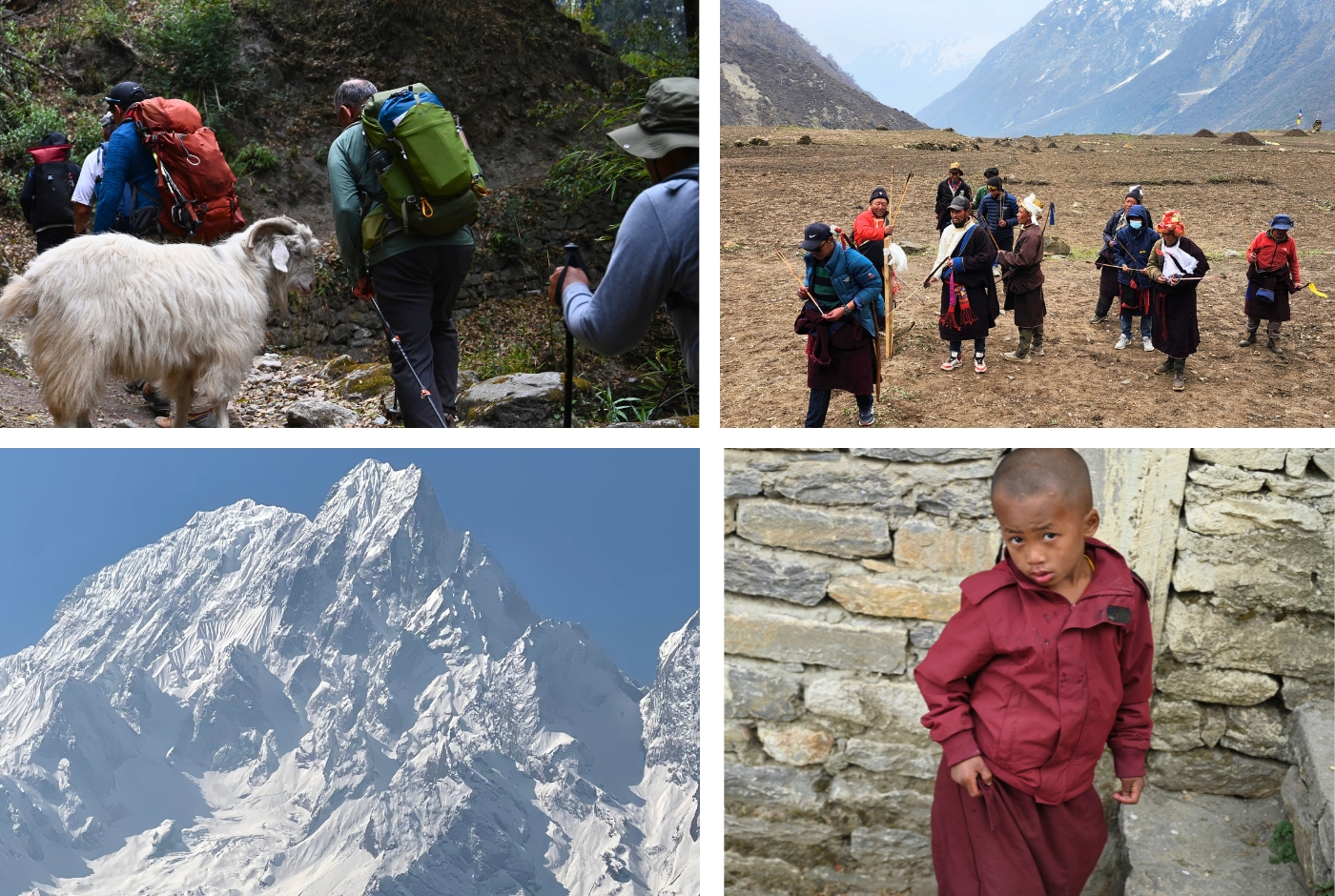
Facts of Manaslu Conservation Area
Area: 1998 km2 (642 sq mi)
Location: Gorkha District
Mammals: 33 species (snow leopard, musk deer, and Himalayan Tahr)
Birds: 110 species
Reptiles: 3 species
Flowering plants: 1500 – 2000
Butterflies: 11 species
Frogs: 4 species
Ethnic groups: Brahmin, Chhetri, Tamang, Tibetan, Magar, and Gurung
Population: 7000 people from Gurung community
Villages: Samagaun, Lho, Prok, Bihi, Chumchet, Chhekampar, Sirdibas.
Tourism in Manaslu Conservation Area: Manaslu circuit trek, Tsum valley trek, Manaslu base camp trek, Nar phu valley trekking
How to get to the Manaslu?
On this trek, the only way of transportation available to go to the Manaslu region is by land transportation. The start point of the trek is Kathmandu. From Kathmandu, you will take a bus to Soti Khola from Bus Park if you would like to have a local experience. You can get a jeep and travel up to Soti Khola comfortably. And from Soti Khola, you officially start your trekking journey. The trek officially ends in Chamje. You will take a bus to Kathmandu from Chamje.
Also, if you are running out of time, then you can drive up to Machha Khola from Kathmandu on the same day. And stay overnight at the Machha Khola. It usually takes two days to reach Machha Khola from Kathmandu, but for people with time constraints, they can arrange it in one day. However, this kind of schedule is difficult to keep up with as it requires you to be active most of the day. In this alternative way, the trek ends at Dharapani. You may take a local or private vehicle from Dharapani to Kathmandu. One con of this alternative route besides the long drive is that you will miss the views of the lower part of the journey.
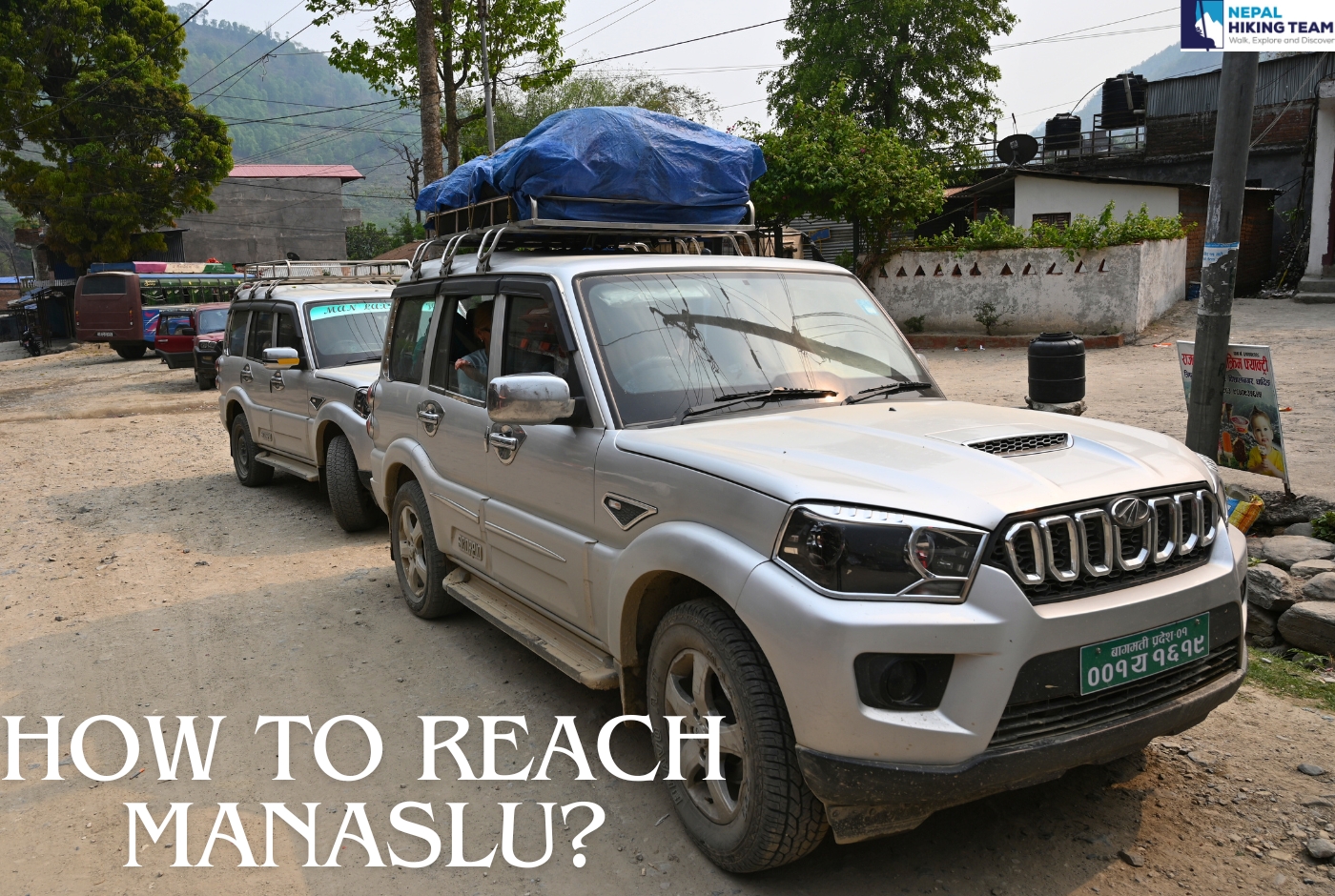
Another fantastic extension in the journey would be the Annapurna Circuit Trek. The Manaslu Circuit trek ends in Dharapani and you start your Annapurna Circuit trek from there onwards. It takes about 8 to 9 days more to do this trek with the Manaslu trek. The journey will start from Dharapni and ends in Jomsom. From Jomsom, you can fly back to Pokhara and drive to Kathmandu. Annapurna Circuit trek in Nepal’s classic teahouse and off the beaten trekking trail that takes you past a wide range of spectacular mountain scenery. Also in an adventure of crossing Thorong La Pass at 5416m, which is probably the highest mountain pass. It has long been considered a world of great treks for its captivating and magnificent cultural and natural beauty.
Manaslu Mountain: Where is Mount Manaslu located in Nepal?
Mount Manaslu, located in the Gorkha district of Nepal, is the eighth-highest mountain in the world, standing at 8,163 meters (26,781 feet). Known as the "Mountain of Spirit," its name comes from the Sanskrit word "Manasa," meaning "soul" or "spirit." Manaslu is famous for its challenging climbing conditions, earning it the nickname "Killer Mountain" due to the high number of fatalities among climbers. The region around Manaslu is rich in cultural diversity and natural beauty, offering a mix of lush forests, remote villages, and panoramic views of the Himalayas.
Facts of Mount Manaslu
Mount Manaslu Height: 8,163m
Province: Gandaki Pradesh
Mountain Range: Mansiri
District: Gorkha
Municipality/Rural Municipality: Nashong/Chum Nubri
Rank: 8th highest peak
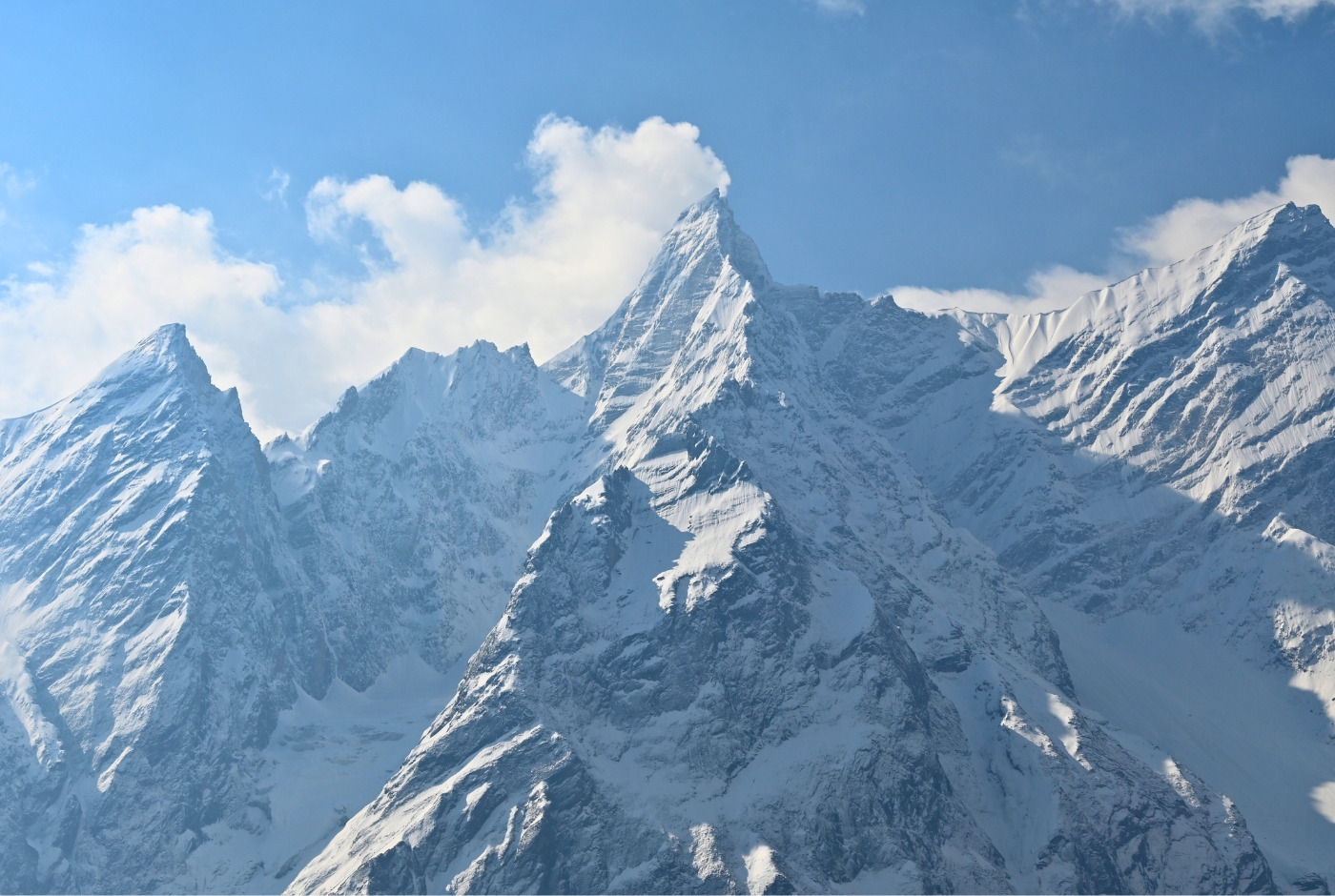
Fees to climb Mount Manaslu
For Nepalese: Spring 10000, Autumn 5000, Winter and Summer 2500
For Foreigners (USD): Spring 1800, Autumn 900, Winter and Summer 450
Why is the Manaslu region trek a restricted area?
Manaslu, which signifies "Mountain of the Spirit'' is one of the less navigated trekking areas of Nepal. The Manaslu was first submitted on May 9, 1956, by Toshio Imanishi and Gyalzen Norbu, individuals from a Japanese expedition group. And Manaslu Region (among Jagat and Dharapani) has been pronounced a restricted trekking region by the Nepal Government for some time now.
The essential explanation regarding this region, as restricted, is to control the travel industry and monitor approaching and active voyagers. The way of life and custom of the Manaslu area is exceptional and dissimilar to some other societies of Nepal. Likewise, the individuals and this district have stayed flawless and unadulterated. Thus, to monitor the number of travelers just as to spare the authenticity of the locale, all things considered, the Manaslu zone is restricted to trekking territory in Nepal.
Best Treks in Manaslu Region: A Complete Guide
A popular trekking destination, the Manaslu Region Trek has recently been recognized for its unique natural and cultural heritage. Introduced as one of the best trekking destinations globally, the Manaslu region presents countless trekking routes, such as the Manaslu circuit, Tsum Valley, and more.
Previously, Manaslu trekking was famous as a camping trek since trekkers used to carry food, and several porters were necessary for moving, making the trekking expensive. Thankfully, several teahouses and lodges have opened in the trekking trails, making trekking easier and relatively cheaper.
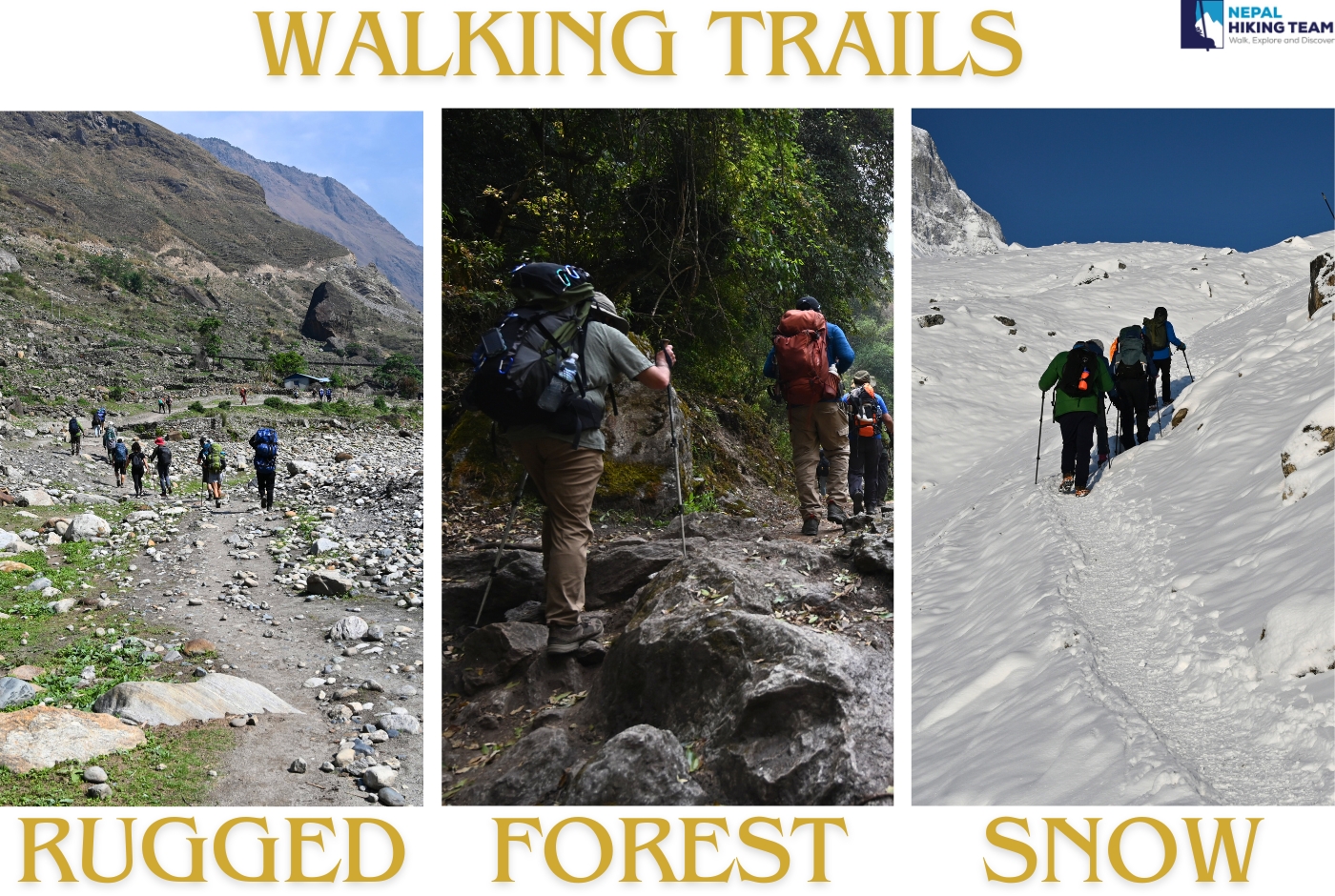
Manaslu region’s trekking trails, which have been untouched and less trodden, are diverse and isolated, making the trekking experience adventurous. The eighth highest mountain in the world, Mt Manaslu (8156m), becomes visible as you trek to the region. Local call Mount Manaslu as ‘Spirit – Mountain’ and consider it holy, believing it to have spiritual deities.
The paths of the Manaslu region hold enthralling landscapes, panoramic vistas of grand mountains, and nineteen wooded areas bearing rhododendrons and bamboo trees. They are home to diverse floras and faunas.
Manaslu Circuit Trek: Off the beaten Trail
Manaslu Trek takes you deep into the Manaslu Region, one of Nepal's most pristine and less touristy Himalayan trekking regions. The Manaslu trail winds around the tropical and lush Budi Gandaki River Valley and climbs up to the base of an eight-thousander named Manaslu, the eighth-highest mountain in the world. A traverse of Larkya La, a 5106-meter high mountain pass, adds thrill to this amazing walking adventure.
The Manaslu Trek offers an authentic Himalayan trekking experience with incredible scenery and mountain culture. Since the region lies in a restricted zone, tourist traffic is quite low, and the villages have pretty much retained their authentic ambiance. For this reason, Manaslu Trek is best suited for those who want to experience the real Nepalese mountain life and landscape devoid of commercialization.
Tentative Daily, Walking Distance and Itinerary of Manaslu Circuit Trek: Expert guide
- Drive Kathmandu to Soti Khola and the total distance for the day is 140 km.
- Soti Khola to Machha Khola and the walking distance for the day is 14.2 km.
- Machha Khola to Jagat and the walking distance is 22.2 km. It is a long and one of the strenuous days on the whole day. So keep your pace up for today's journey.
- Jagat to Deng and the walking distance is 20 km.
- Deng to Namrung and the walking distance is 19.4 km. This another long day in the trek. You will cover almost the same distance as the day before, you take rest and eat healthily.
- Namrung to Lho Gaun and the walking distance is 10.5 km.
- Lho Gaun to Samagaon and the walking distance is 8.1 km.
- Samagaon to Samdo and the walking distance is 8.1 km.
- Samdo to Dharamsala and the walking distance is 6.6 km.
- Dharamsala to Bhimphedi via Larkya La Pass and the walking distance is 24.5 km. This is another long and strenuous day because not only will you be walking for hours, you will also cross Larkya La pass at the great height of 5100 m.
- Bhimphedi to Tilje and the walking distance is 26 km. It is another long walking day.
- Hike from Tilje to Chamje and the walking distance is 19.4 km. It is the last walking day of the trek.
- Drive from Chamje to Kathmandu and the distance between two journeys is 215 km
Tsum Valley Trek: Hidden Trekking Trails
Tsum Valley is an interesting side trip en route that takes you to places that were opened to outsiders as recently as the beginning of this century. The hidden Tsum Valley, which lies in the Manaslu Region, was opened for tourism only in 2008. Prior to that, the valley remained cut off from the outside world.
In this remote valley of Tsum, centuries-old traditions and customs are still being followed. Shyagya, or the nature-culture conservation practiced by the people of Tsum, might teach the modern world a thing or two about environment conservation and sustainability.
The Tsum Valley is divided into Upper Tsum and Lower Tsum. In total, there are 33 villages in the valley. The people of the Tsum Valley have their own dialect, known as Tsumba or Tsumke. A unique fact about the Tsum Valley is that all animals, birds, and insects are protected and allowed to exist without any interference from human beings.
The culture of 'Shyagya' guides the lifestyle of the people of Tsum. Shyagya, which means a tradition of non-violence in Buddhism, has been adopted by the people of Tsum. People in the valley are strictly prohibited from hunting, harvesting honey, killing animals, trading animals or their parts, burning forests, and trapping birds, animals, or insects.
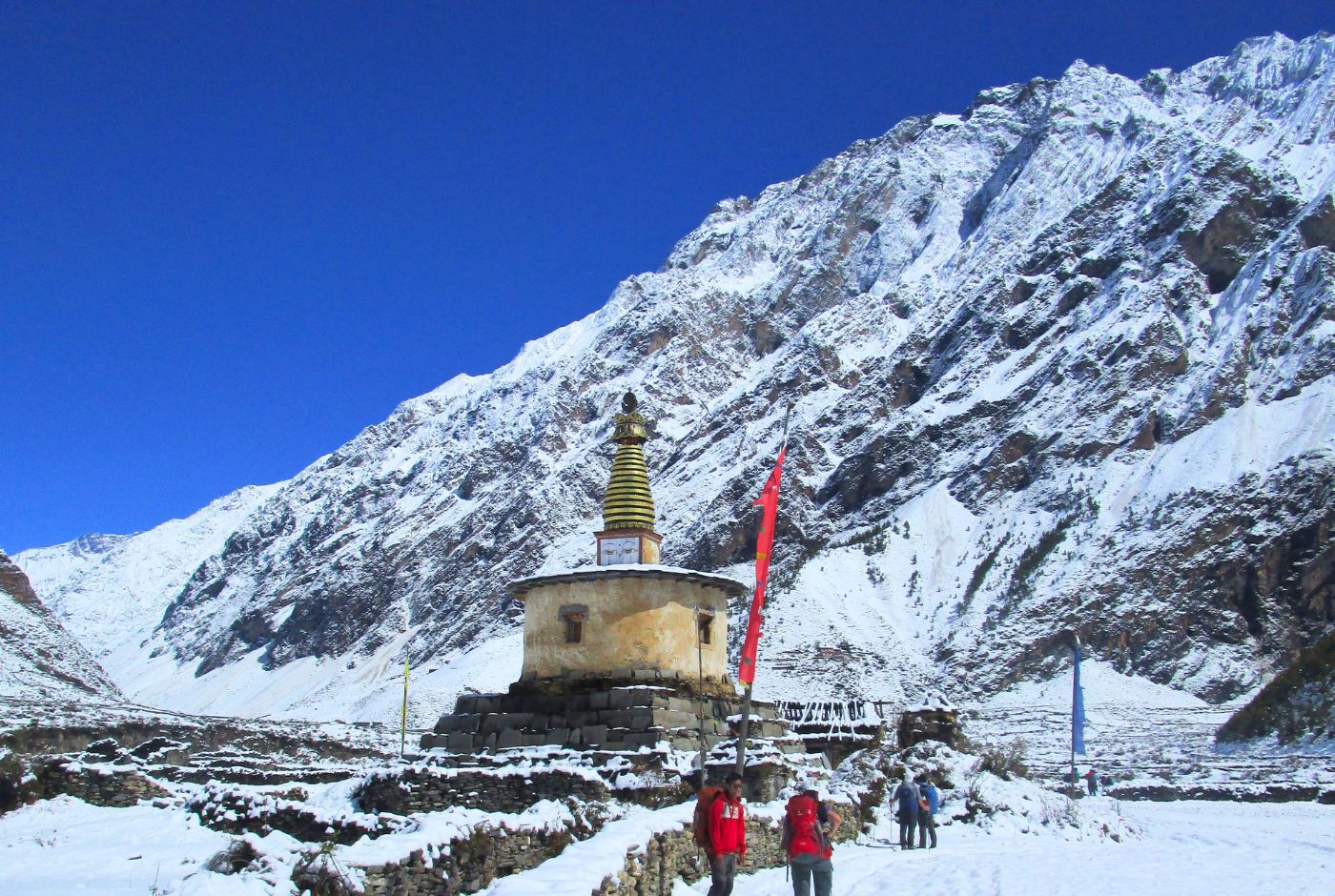
Tentative Daily, Walking Distance and Itinerary of Tsum Valley Trek: Detail Information
- Drive Kathmandu to Machhakhola and the total distance for the day is 160 km.
- Machhakhola to Jagat and the walking distance for the day is 22 km.
- Jagat to Lokpa and the walking distance is 21 km.
- Lokpa to Chumling and the walking distance is 19 km.
- Chumling to Chokangparo and the walking distance is 14 km.
- Chokangparo to Nile and the walking distance is 19 km.
- Nile to Mu Gompa and the walking distance is 8 km.
- Mu Gompa to Rachen Gompa and the walking distance is 14 km.
- Rachen Gompa to Chumling and the walking distance is 19 km.
- Chumling to Lokpa and the walking distance is 19 km.
- Lokpa to Jagat and the walking distance is 21 km.
- Jagat to Machhakhola and the walking distance is 22 km.
- Drive from Machhakhola to Kathmandu, and the distance between two journeys is 160 km.
Why Choose Manaslu Trek in Nepal: 15 reasons to choose Manaslu Region Trek
Authentic Himalayan Trekking Experience
One thing Manaslu has to offer that the popular treks in Nepal have lost over the years is the authentic culture. Here you will find villagers who actually make their living from farming and cattle rearing and not as tourism entrepreneurs (as in the Everest and the Annapurna regions). The villagers do the same work their forefathers used to do. Here you will discover what village life was like in the mountainous trekking regions of Nepal before the boom of commercial trekking took over and transformed the lifestyle of the people.
Less Touristy and Less Commercialized
Since the Manaslu Region is a restricted zone, one has a pay a permit to enter the region. This makes the trek much pricier than other treks in Nepal – a reason that makes backpacking tourists stay away from the trail. Only a few groups who are really interested in discovering the amazing Manaslu area make it to the trail. And their numbers are very few.
The restricted flow of tourists has meant less disturbance and changes in the lifestyle of the locals. Unlike in the busy routes of Annapurna and Everest, you won't find many locals involved in the tourism business. While some may have opened lodges to cater to the tourists, most of them are still involved in farming and cattle rearing.
Pristine Nature of Manaslu
From the beginning to the end of your trek, you will be walking in a virgin and pristine trail. The trek starts from the humongous tropical forests of the Budhi Gandaki River Valley and goes up to the cold arctic zone of the Manaslu Base Camp and Larkya La. With few villages in between, the landscape is undisturbed and pristine. One can encounter glaciers, waterfalls, and streams en route, which flow down and meet the roaring Budhi Gandaki.
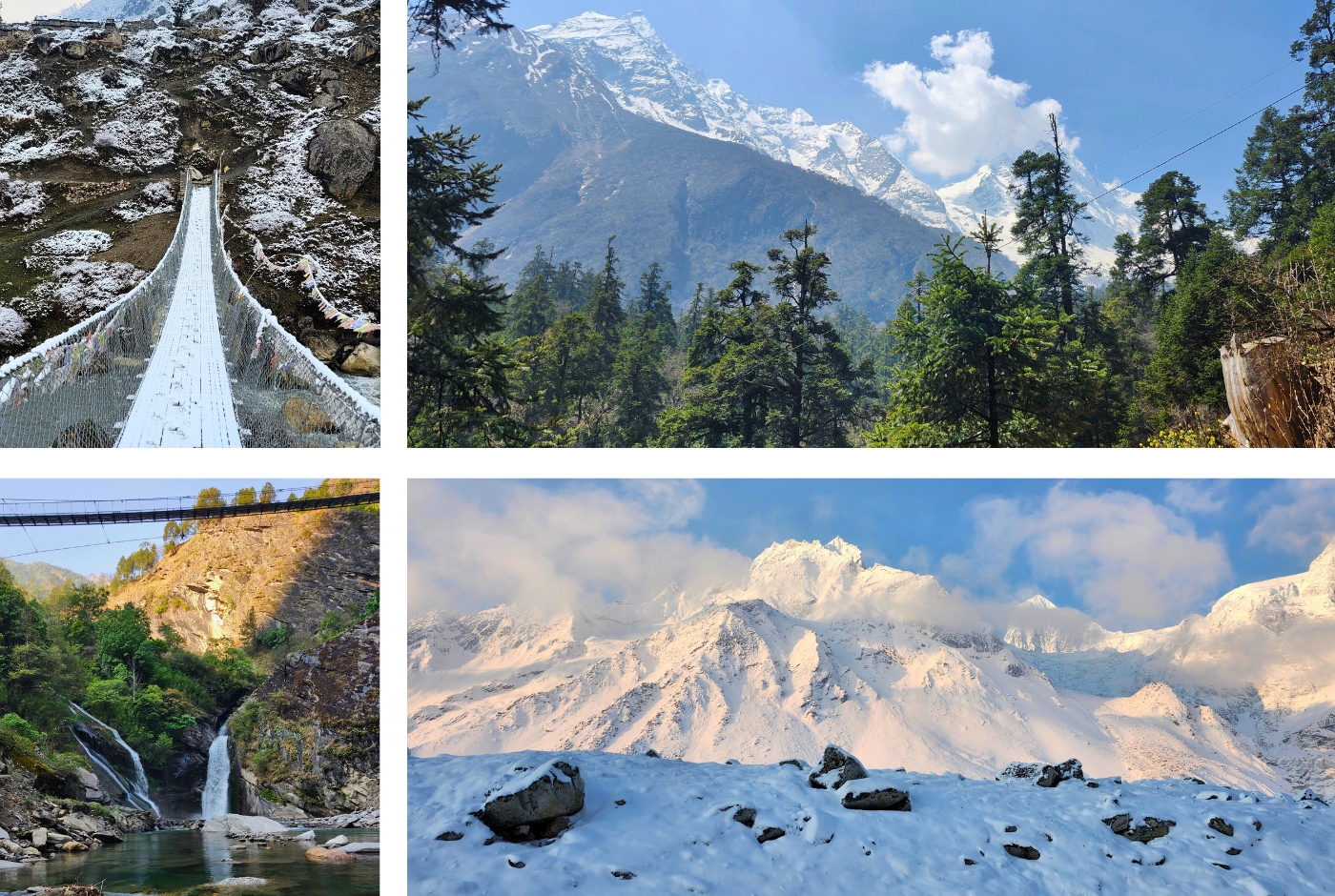
Suspension bridges connect deep gorges with thundering rivers flowing below. Trails are cut in rocky cliffs with exposed sides, which offer majestic views of the mountains and valleys. You will be walking through forests filled with oak, bamboo, pine, juniper, and birch trees. Much of the trail falls under the Manaslu Conservation Area, a protected zone.
Diverse Landscape and Culture
While trekking in the Manaslu Region, you will come across diverse terrain and culture. You will start your trek either from Soti Khola or Macha Kola, which lies at an elevation below 2500 meters and climb up to an altitude above 5000 meters. From the lush and humid jungles of the Budi Gandaki valley, you will reach the frozen, snow-covered slopes of the Larkya La. You will be crossing forests with a thick cover of trees and abundant greenery and climbing snow-blanketed hills with not a single tree in sight.
The trail takes you across villages of different ethnic groups that follow Tibetan Buddhism and Hinduism. In the lower Budhi Gandaki Valley, you will find Hindu settlements of Gurung, Chettri, and Brahmin communities surrounded by terraced rice fields and banana plantations.
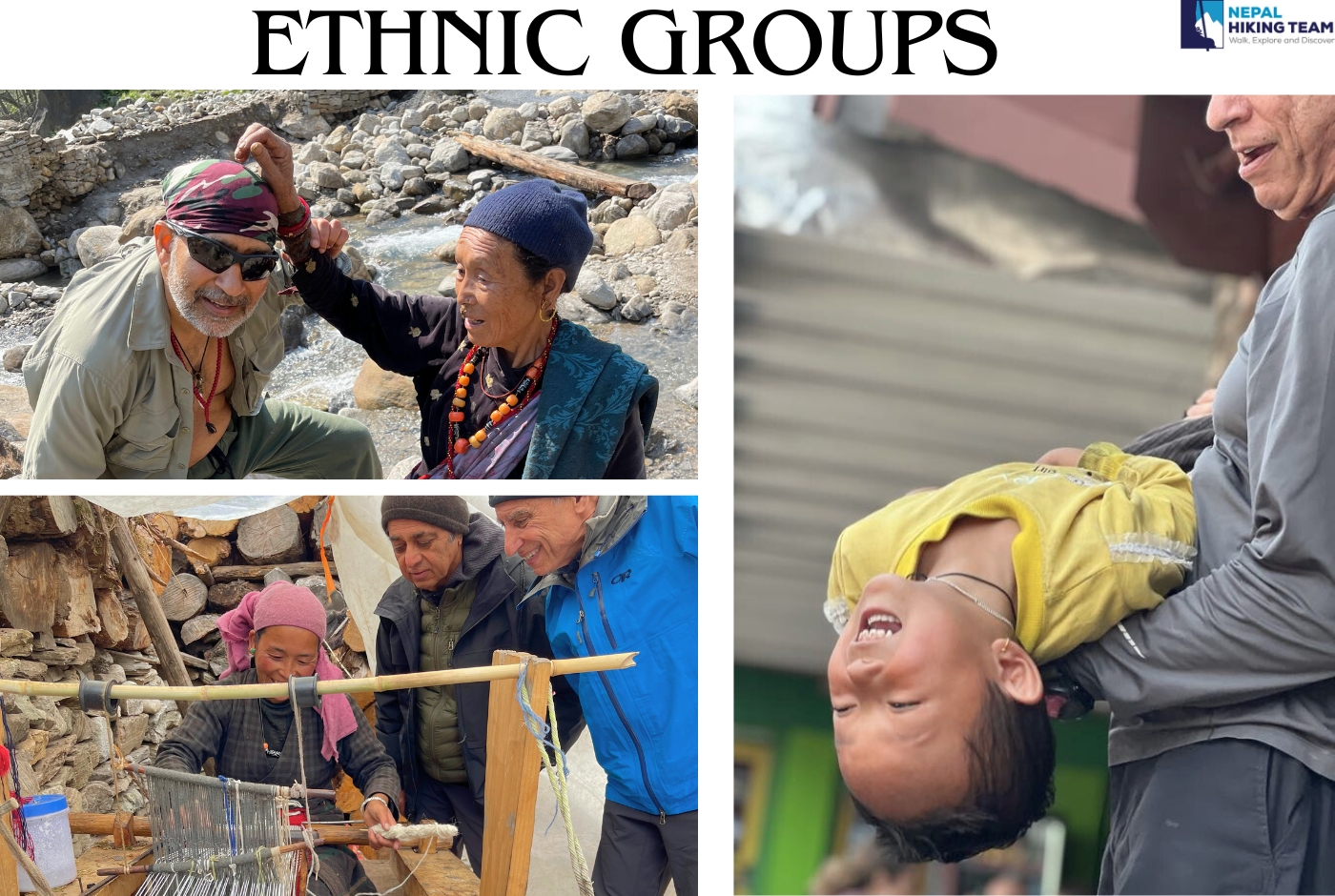
As you head higher, you will come across villages that have deep links with Tibet. Here, people follow Tibetan Buddhism and Bon (an animistic religion that is more ancient than Buddhism). The language, daily lifestyle, and customs are similar to those in the Tibetan Highlands. In fact, people in this remote corner of Nepal seem to have preserved the Tibetan traditions much better than the actual Tibetans in the Tibetan Highlands.
Tibet has seen some major development and urbanization under the Chinese government. In the last couple of years, the rural belt, including the Tibetan villages, has also been vastly modernized, leading to the erosion of age-old customs, traditions, and lifestyles. In this corner of Nepal, it is possible to experience the authentic Tibetan Buddhist culture and lifestyle.
Ethnic Groups around Manaslu Region
| Ethnic | Group | Description | Culture and Traditions |
| Nubri | Nubri Valley | Inhabit the Nubri Valley, with strong Tibetan cultural influence. | Strong Buddhist traditions; known for monasteries, mani walls, chortens, and Tibetan-style art and rituals. |
| Tsum | Tsum Valley | Live in the relatively isolated Tsum Valley, retaining a unique traditional culture. | Rich in Tibetan Buddhist culture with a focus on religious landmarks and festivals. |
| Kutang | Kutang Valley (Lower Nubri) | Found in the lower regions of Nubri, also known as Kutang. | Buddhist, with cultural similarities to the Nubri and strong Tibetan influences. |
| Gurung | Central Hills of Manaslu | Found in the central hills; many have served in the Gurkha army. | Mix of Buddhist and Hindu traditions; known for bravery in the Gurkha army. |
| Bhutia (Bhotia) | Near Tibetan Border | Tibetan-origin ethnic group with flat-roofed houses, closely related to Sherpas. | Buddhist, with strong Tibetan cultural influence, marked by distinct religious architecture and practices. |
| Brahmin, Chhetri | Lower Region of Manaslu | Found in lower region of Manaslu | Hindus |
Safer than most high-altitude treks
It is mandatory to trek with a guide in the Manaslu Region. Since this is a restricted zone, solo or independent trekking is not allowed. Having a guide with you automatically makes this trek safer than most treks in the Nepal Himalayas. With a guide, navigating the route won't be a problem as he will know which trail to take and how to get from point A to point B safely and swiftly.
Most of the Manaslu Region is a wild country with very few villages in between. Sometimes you will have to walk for six to eight hours to reach the next village. While the trail is well-marked and walkable, having a guide with you in the wilderness will keep you safe. He will also handle all the logistics, which will make your trek stress-free.
However, it's important to take care of your personal health while trekking. Hiking in high altitude is always risky, and you should take appropriate precautions to save yourself from altitude sickness.
View of amazing mountains including an Eight-thousander
The Manaslu Trek takes you close to Mount Manaslu. Rising to a height of 8,163 meters, Manaslu is one of the world's fourteen eight-thousanders and the eighth-highest mountain in he world. A brisk hike from the ancient village of Samagaon takes you close to the base camp of Manaslu and lets you enjoy the magnetic beauty of its snow-draped summit.
Known as the 'Spirit Mountain,' locals worship this mountain and regard it as their guardian deity. Killing and harming of all living beings, including animals, birds, and insects, is strictly prohibited in the settlements close to the mountain. On the way to the Mount Manaslu Base Camp, you will come across a beautiful mountain lake, Birendra Taal. The turquoise lake surrounded by snow-covered mountains looks stunning.
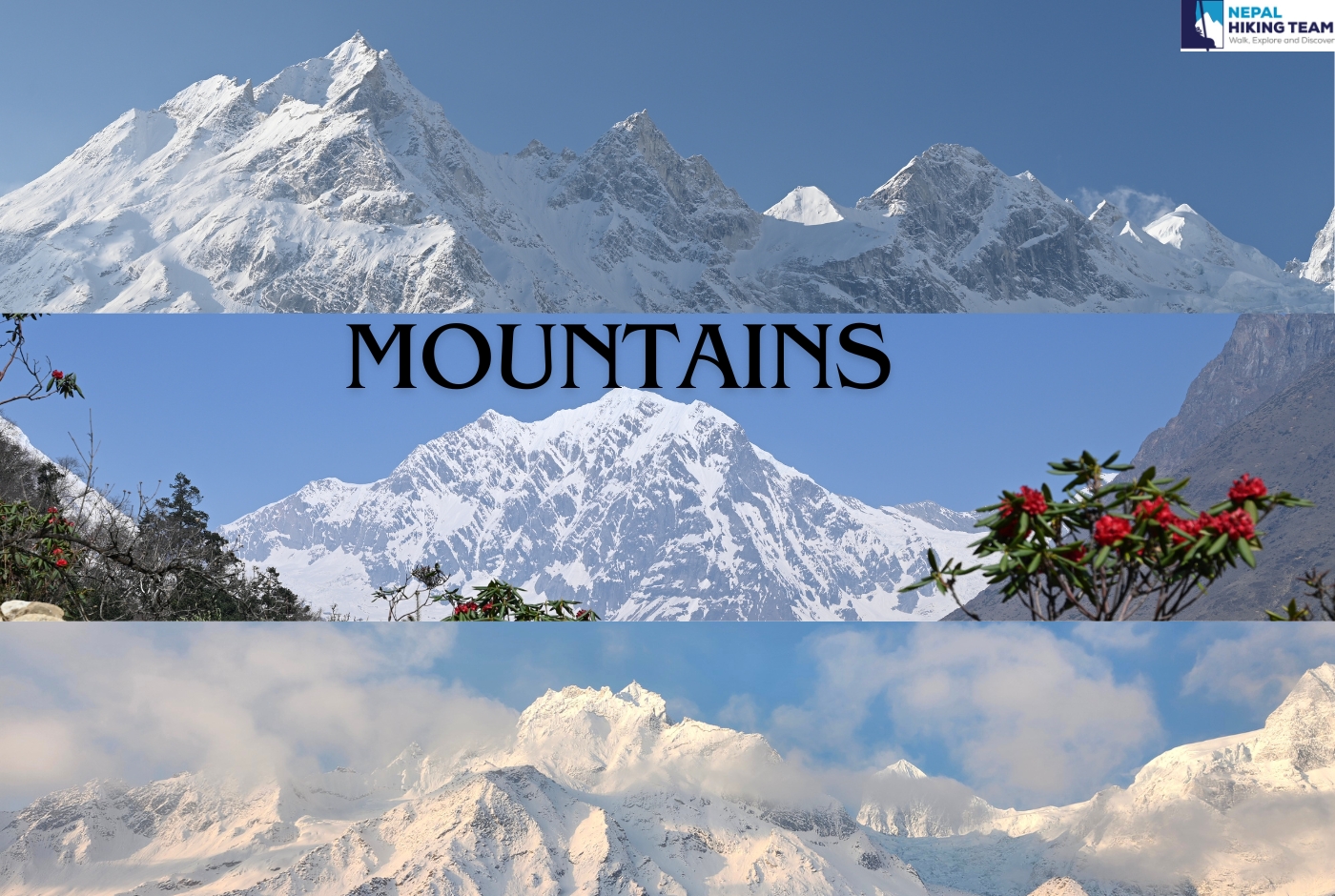
During peak climbing season, the base camp is covered with tented camps of mountaineering groups hoping to conquer Mount Manaslu. While the mountain is smaller than Mount Everest, climbing its summit is a lot more technical and challenging, according to seasoned climbers. Himalchuli, Naike Peak, Ganesh Himal, and Shringri Himal are some of the other mountains you can view closely from the base camp.
List of mountain names seen from Manaslu Route:
| Peak Name | Elevation(meters) | Elevation (Feet) | Description | Visible form |
| Mount Manaslu | 8,163 | 26,781 | 8th highest mountain in the world | Lho, Sama Gaon, Samdo |
| Himalchuli | 7,893 | 25,896 | The second highest peak in the Mansiri Himal range | Lho, Sama Gaon |
| Ngadi Chuli (Peak 29) | 7,871 | 25,823 | A significant peak of the Manaslu range | Lho, Sama Gaon |
| Shringi Himal | 7,187 | 23,579 | Located to the west of the Budhi Gandaki River | Deng, Prok |
| Ganesh Himal II | 6,672 | 23,353 | Part of the Ganesh Himal range | Lho, Sama Gaon |
| Cheo Himal | 6,820 | 21,889 | Prominent peak close to the border of Tibet and Nepal | Larkya La Pass |
| Larke Peak | 6,249 | 22,375 | A sharp peak in the Manaslu range | Larkya La Pass |
| Ribung La | 5,670 | 18,602 | Close to Larkya La Pass | Lho, Sama Gaon |
| Langpo (Langpo Peak) | 6,668 | 21,875 | Remote areas northeast of Sama Gaon | Not visible from the standard Manaslu Circuit route; situated in a more remote region closer to Tibet |
| Saula Himal | 6,235 | 20,455 | Remote areas north of Sama Gaon | Saula Himal is not visible from the standard trek but lies further north. |
Cross Larkya La (5106m), a high Himalayan Mountain Pass
One of the highlights of this trek is the difficult crossing of a high mountain pass, Larkya La. Larkya Peak is one of the smaller peaks located close to Mount Manaslu, and the Larkya La Pass goes through this mountain. Crossing the Larkya La certainly hikes up the thrill factor of this trek.
The crossing is done early in the morning from Dharamshala or Samdo when it is still dark to avoid avalanches and high winds (which tend to roll in as the day progresses). While no technical climbing is required to cross the Larkya La, it is nevertheless challenging to walk over the pass. The pass is covered with snow whole year round and some sections are covered with slippery ice. The descent to Bimthang from the pass is extremely steep and icy. You need to have the right equipment and gear to make it over the pass safely.
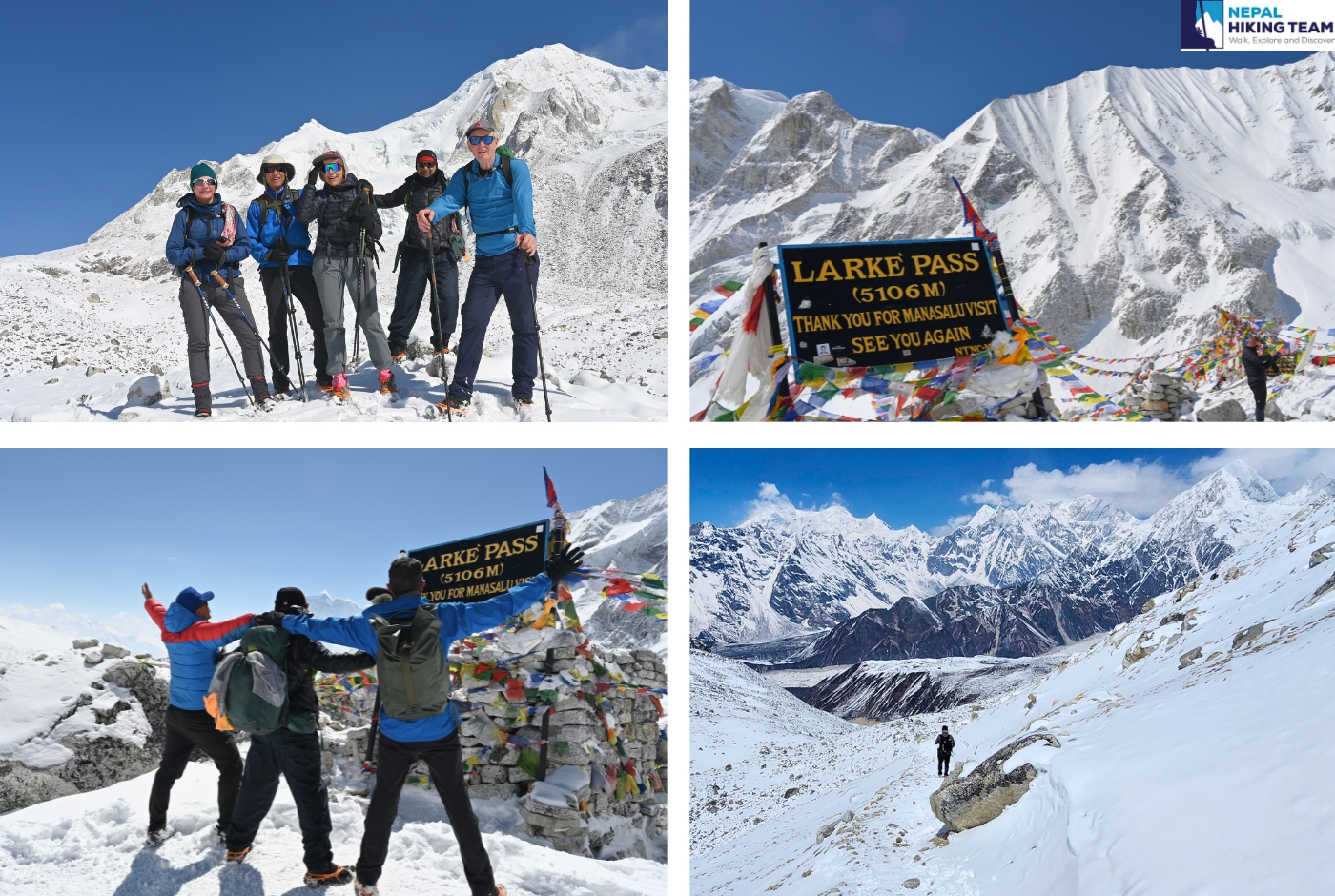
Facts of Larkya La Pass
Location: Manaslu region of Nepal, within MCA or Manaslu Conservation Area
Trekking Route: Manaslu Circuit Trek
Elevation: 5106 m (highest point for trekkers around Manaslu)
Difficulty: Strenuous
Views: Panoramic view of stunning Himalayas (Mt. Manaslu, Himlung Himal, Cheo Himal)
Weather: Unpredictable
No Risky Mountain Flight
There is road connectivity to the trailhead from Kathmandu. This means you won't have to stress about taking a risky flight on a tiny plane across the mountains to the trailhead. Taking a ride on a vehicle instead of a flight will also cut down your transportation costs. The more people in your group, the less you will have to pay individually. It takes around 7 to 8 hours' drive from Kathmandu to reach the trailhead.
Rich Biodiversity
The Manaslu Trek goes through the protected Manaslu Conservation Area, which is a rich storehouse of Himalayan flora and fauna. The conservation park covering an area of 1663 square kilometers, is home to rare animals like the Snow leopard. Himalayan Musk Deer, Blue Sheep, Himalayan Black bear, lynx, Himalayan Tahr, Himalayan Marmot, etc.
The conservation area has more than a hundred species of birds and two thousand species of plants. Here, you will find eleven types of forests and six climatic zones – tropical, sub-tropical, temperate, alpine, sub-alpine, and arctic. The variation in climate makes this region one of the richest biodiversity hotspots in the Himalayas.
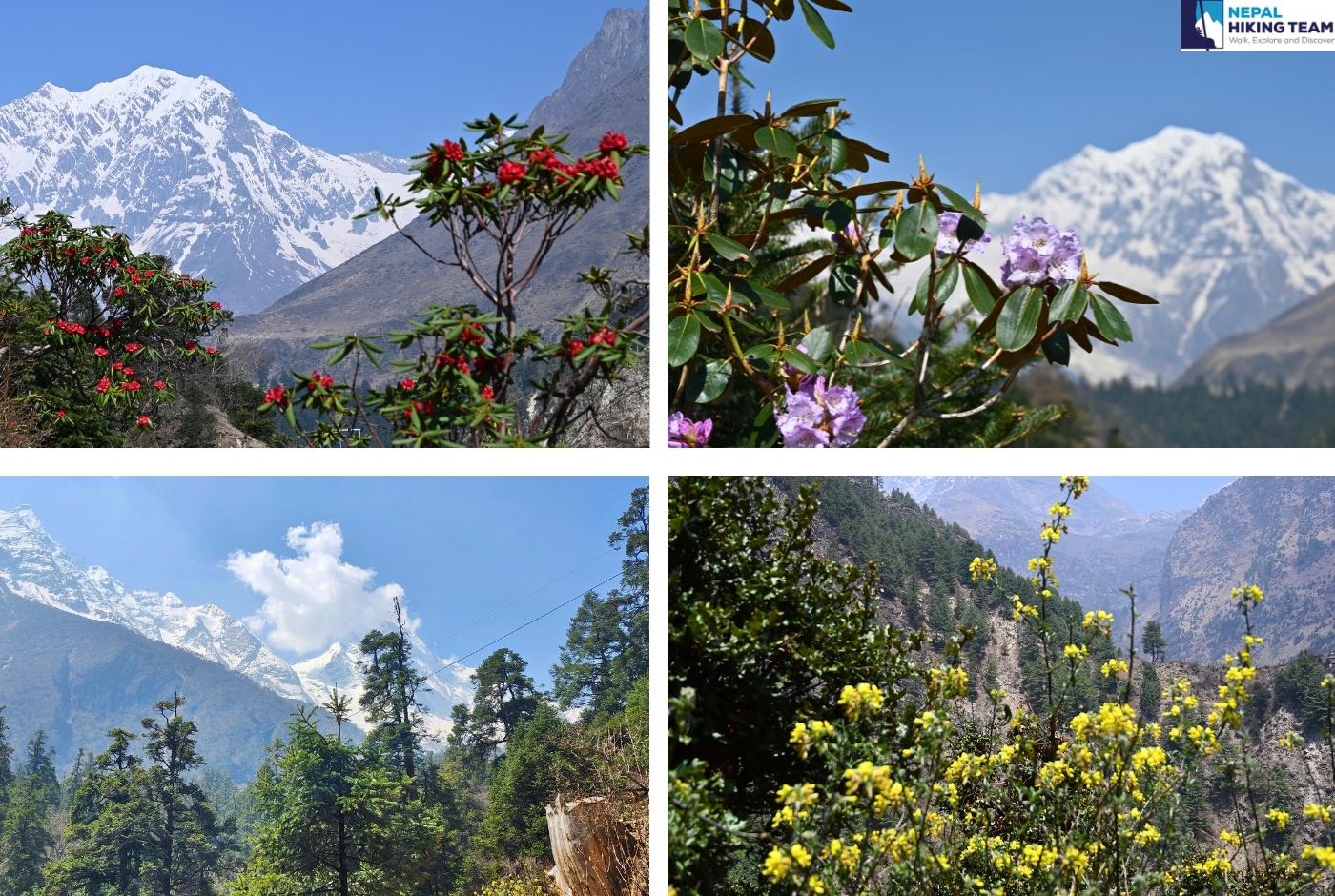
Flora and fauna in Manaslu region
Fauna in Manaslu Region
List of flora found in Manaslu Region in tabular format:
| Group | Species | Description |
| Endangered Mammals | Snow Leopard, Red Panda | Highly endangered species; the area serves as a sanctuary for these animals |
| Other Mammals | Lynx, Asian Black Bear, Grey Wolf, Dhole, Assam Macaque, Himalayan Musk Deer, Blue Sheep, Himalayan Tahr, Mainland Serow, Himalayan Goral, Woolly Hare, Horseshoe Bat, Himalayan Mouse-Hare, Black-Lipped Pika | The region hosts a variety of mammals, from large predators like the grey wolf to smaller species like the black-lipped pika |
| Birds | Golden Eagle, Eurasian Griffon, Himalayan Griffon, Blood Pheasant, Impeyan Pheasant, Kalij Pheasant, Koklass Pheasant, Himalayan Snowcock, Tibetan Snowcock, Crimson Horned Pheasant | Around 110 species of birds have been recorded, including various types of pheasants and snowcocks, as well as large raptors like the golden eagle |
| Butterflies | 11 Species | Diverse butterfly species have been recorded in the region |
| Reptiles | 3 Species | Reptile diversity is relatively low compared to other groups |
| Conservation Efforts | Hunting Ban Enforced by Monasteries | Monks in the region have put a hunting ban in place, allowing wildlife to thrive. The area is a key habitat for species like the snow leopard and blue sheep |
Fauna in Manaslu Region
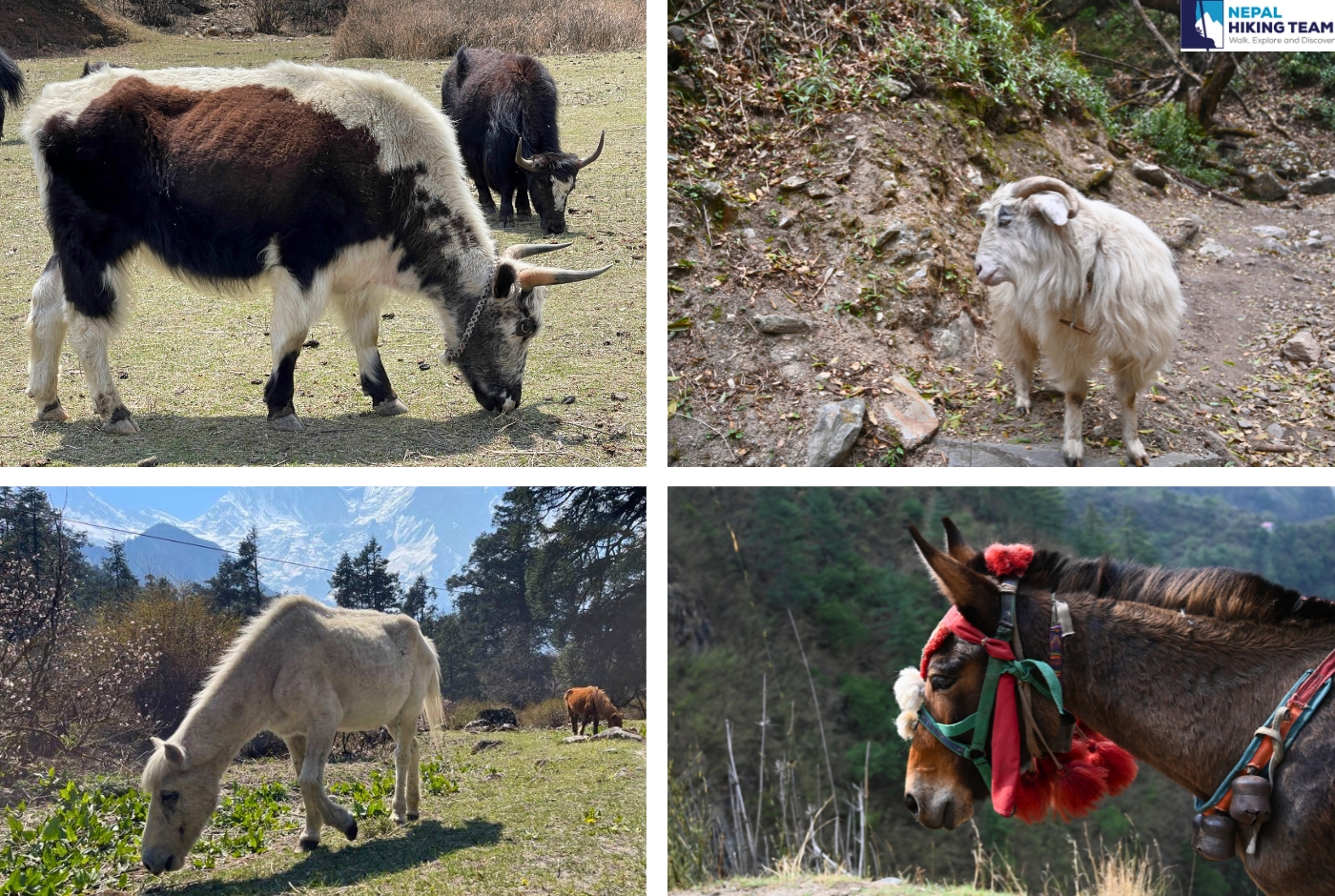
List of Fauna found in Manaslu Region in tabular format:
| Category | Description | Forest Types & Species | Notable Flora |
| Low Hill | Found at lower elevations with a mix of different forest types. | Broad-leaved forests, Sal forests, Schima-Castanopsis forests | Rich in rhododendrons, orchids, ferns, and various flowering plants. |
| Middle Mountain | Found at mid-range elevations with a mix of low and high mountain trees. | Coniferous forests, Oak forests | Himalayan blue pine, spruce, fir, birch, medicinal plants like Kutki and Jatamansi. |
| High Mountain | Found at high elevations with a colder climate and sparser vegetation. | Subalpine forests, Rhododendron forests, Alpine meadows | Juniper, dwarf rhododendrons, high-altitude grasses, many medicinal herbs and aromatic plants. |
| Forest Diversity | The Manaslu Conservation Area boasts a remarkable variety of plant life. | 16 different forest types documented (may vary depending on source) | Rhododendron forests, Himalayan blue pine forests, broad-leaved forests, Sal forests, Schima-Castanopsis forests, coniferous forests, oak forests, subalpine forests, alpine meadows |
| Plant Species | The area is home to a vast array of plant life. | Over 1,500 - 2,000 flowering plant species are estimated. | Rich in rhododendrons, orchids, ferns, medicinal herbs (Kutki, Jatamansi), aromatic plants, Himalayan blue pine, spruce, fir, birch, broad-leaved trees, Sal trees, Schima and Castanopsis trees, high-altitude grasses, dwarf rhododendrons, junipers. |
| Medicinal & Aromatic | Plants Many plants with traditional medicinal and aromatic uses are found throughout the region. | Grow in various forest types, especially near forest edges. | Used in traditional medicine and for creating fragrances. Examples include Kutki, Jatamansi, and various aromatic herbs. |
No Roads and Noisy Vehicles
Unlike the busy Annapurna Circuit, there are no roads on the Manaslu trail. Much of the trail is still pristine and untouched. So you can look forward to a peaceful walk on foot trails filled only with nature sounds. As you won't have to share the trail with local buses and land cruisers, there will be no noisy vehicles revving past, no plumes of dust, and no blaring horns disturbing the peace and quiet of the mountains.
So there you go. Those are the ten points that we feel make the Manaslu Trek or Circuit unique from other treks in Nepal. However, here are some more points which we believe make the trek to Manaslu a once-in-a-lifetime experience.
Compared to other treks, the trekking experience across Manaslu is quite enriching and unique. Leaving aside the above ten points, Manaslu Trek is a must-do for the following reasons.
Buddhist Culture and Monasteries around Manaslu
Manaslu Region is home to some of Nepal's oldest Buddhist monasteries and nunneries. There are meditation caves and shrines blessed by the Second Buddha or Padmasambhava. Milarepa, or the 'singing Buddhist saint," is said to have spent a good number of years meditating and roaming around the hills of this region. For followers of Tibetan Buddhism, the Upper Manaslu area is an important pilgrimage site. They believe these are beyuls, a hidden paradise created by Guru Rinpoche. People who live in these beyuls are said to be blessed and lucky.
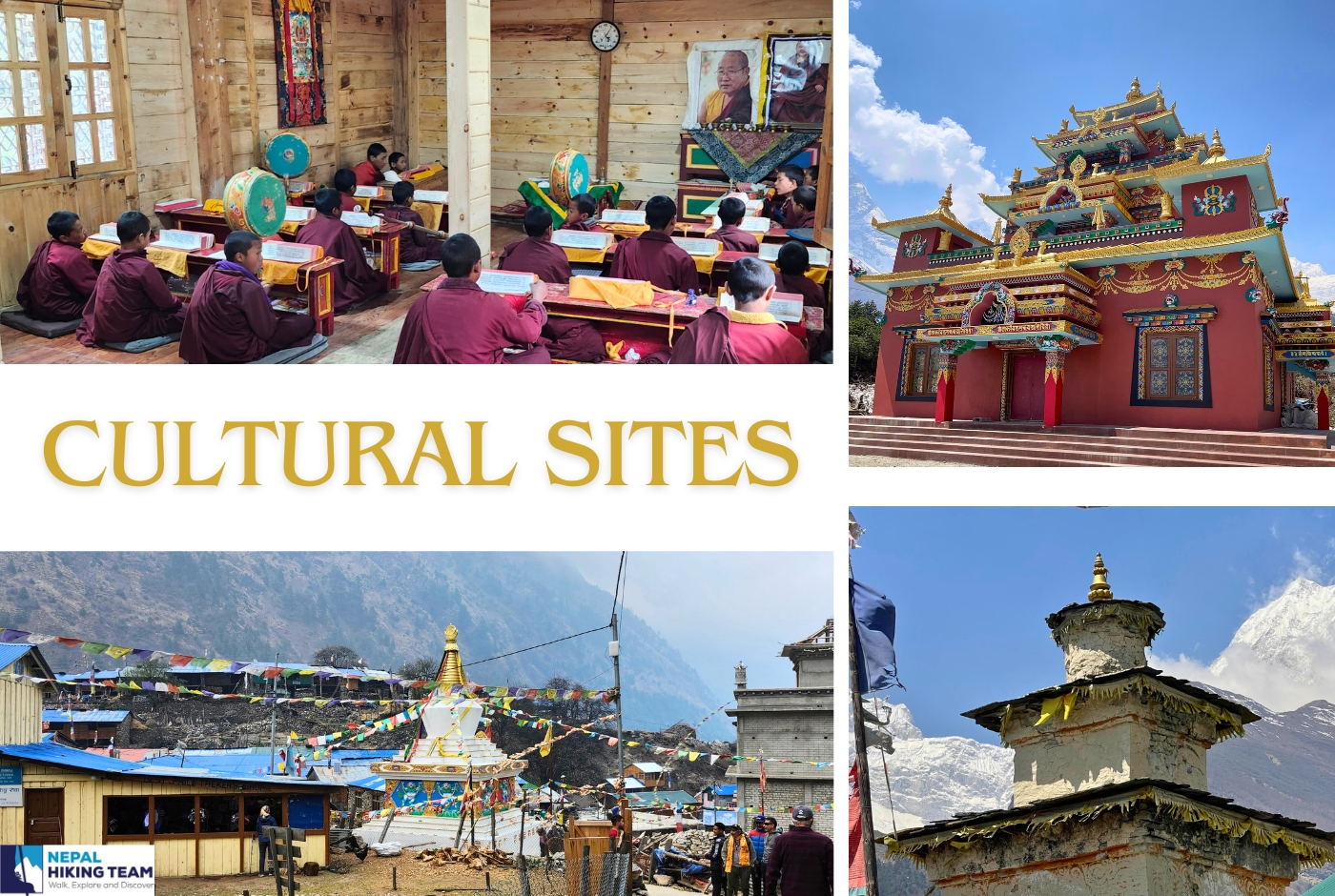
Mu Gompa, Rachen Gompa, Serang Gompa, Hinang Gompa, Gompa Naktsal, Pungen Gompa, etc., are some of the ancient and important Buddhist monasteries in the region. Most of these monasteries date back several centuries and provide refuge to hundreds of monks(lamas) and nuns(anis) who devote their lives to spreading 'Dharma'. These monasteries are also home to the valuable Buddhist manuscripts and texts that were brought over from Tibet by fleeing monks who escaped the invasion of Tibet by the Chinese Red (communist) Army.
| Monastery Name | Location | Culture/Religion | Description |
| Kargyu Chholing Monastery | Samagaon Village | Tibetan Buddhism | Significant monastery in Samagaon, known for its large Guru Rinpoche statue. A spiritual center and important stop for trekkers. |
| Sama Gompa (Ribung Gompa) | Samagaon Village | Tibetan Buddhism | Major monastery, the spiritual heart of Samagaon with continuous chanting by monks. Reflects the strong Tibetan influence. |
| Mu Gompa | Tsum Valley, near Mu Village | Tibetan Buddhism | Highest monastery in Tsum Valley (3,700 meters), offering a serene environment for meditation and spiritual retreat. |
| Rachen Gompa | Tsum Valley | Tibetan Buddhism | Significant nunnery housing a large number of nuns. Plays a key role in preserving the Tsum Valley's spiritual and cultural heritage. |
| Lho Monastery | Lho Village, Manaslu Circuit Trek | Tibetan Buddhism | Central to religious life in Lho Village. Offers insights into local Buddhist practices with stunning views of Mount Manaslu. |
| Shringi Gompa | Bihi Village | Tibetan Buddhism | Lesser-known monastery with deep spiritual roots. An important site for local pilgrims near Shringi Himal, playing a role in local culture and religion. |
| Pungyen Gompa | Near Samagaon Village | Tibetan Buddhism | Secluded and sacred site on a ridge with breathtaking Manaslu Glacier views. Often visited for spiritual solitude and associated with local deities, it has a rich history. |
Unique Festivals Around Manaslu Region
While the Hindu population in the lower part of the Manaslu Region celebrates Hindu festivals that are observed in all parts of Nepal, the Buddhist settlements in the higher elevations celebrate some unique Buddhist festivals. These festivals are celebrated only in the Trans Himalayan regions inhabited by followers of Tibetan Buddhism.
Losar, or the New Year according to the Tibetan lunar calendar, is celebrated with much joy and fanfare. All the villagers wear new clothes and clean their houses during this festival. They visit the monasteries and Buddhist shrines and pray for a good year filled with good health, happiness, and prosperity.
Dhachyang, or the Horse Racing Festival, is an amazing festival where male riders vie for the top spots in horse racing and other competitions. The horse riding competition is followed by group dancing and singing.
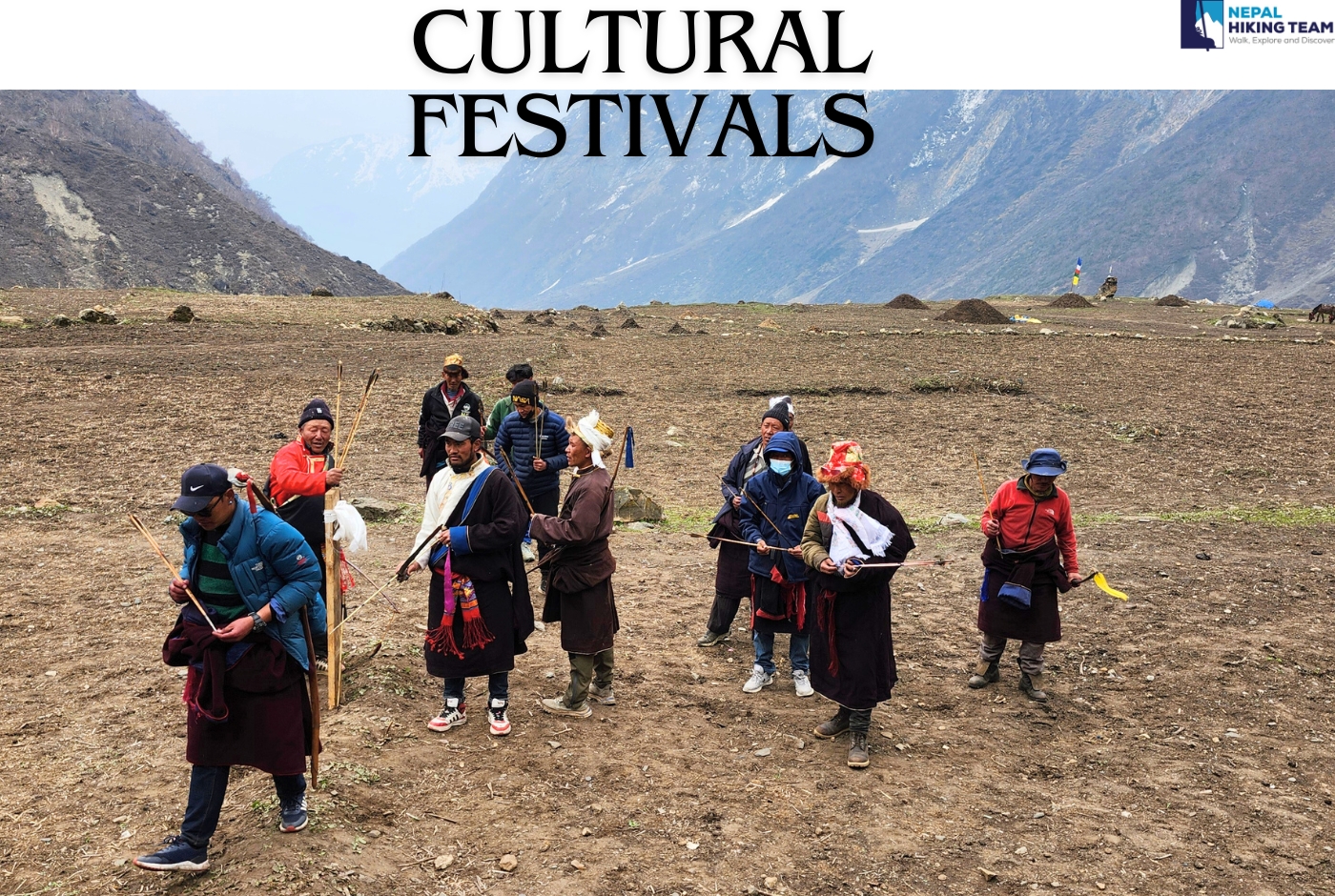
The festival of Saka Dawa commemorates the life of Lord Gautama Buddha – his birth, enlightenment, and Parinirvana. During the festival, people make it a point to do meritorious deeds and visit monasteries.
The festival of Faning is about nourishing oneself. Delicious meals are cooked, and people treat themselves to nutritious and healthy food. Nara, a masked dance festival, is celebrated at different times of the year at different monasteries in the Tsum Valley. It is mainly observed to cleanse the spirit and the environment of bad and evil spirits.
Explore the best Time for Manaslu Region Trekking
The ideal opportunity for the Manaslu Trek would be in the fall and spring of Nepal. The two seasons offer favorable climatic conditions and environments for explorers. The climate and the ambiance around these times are fascinating. The weather is excellent, calm, and luscious surrounding keeps on developing. Therefore, even though both seasons are an ideal time to visit Nepal and do trekking in the Manaslu area, you will have different weather to experience.
Manaslu Trek in Spring Season
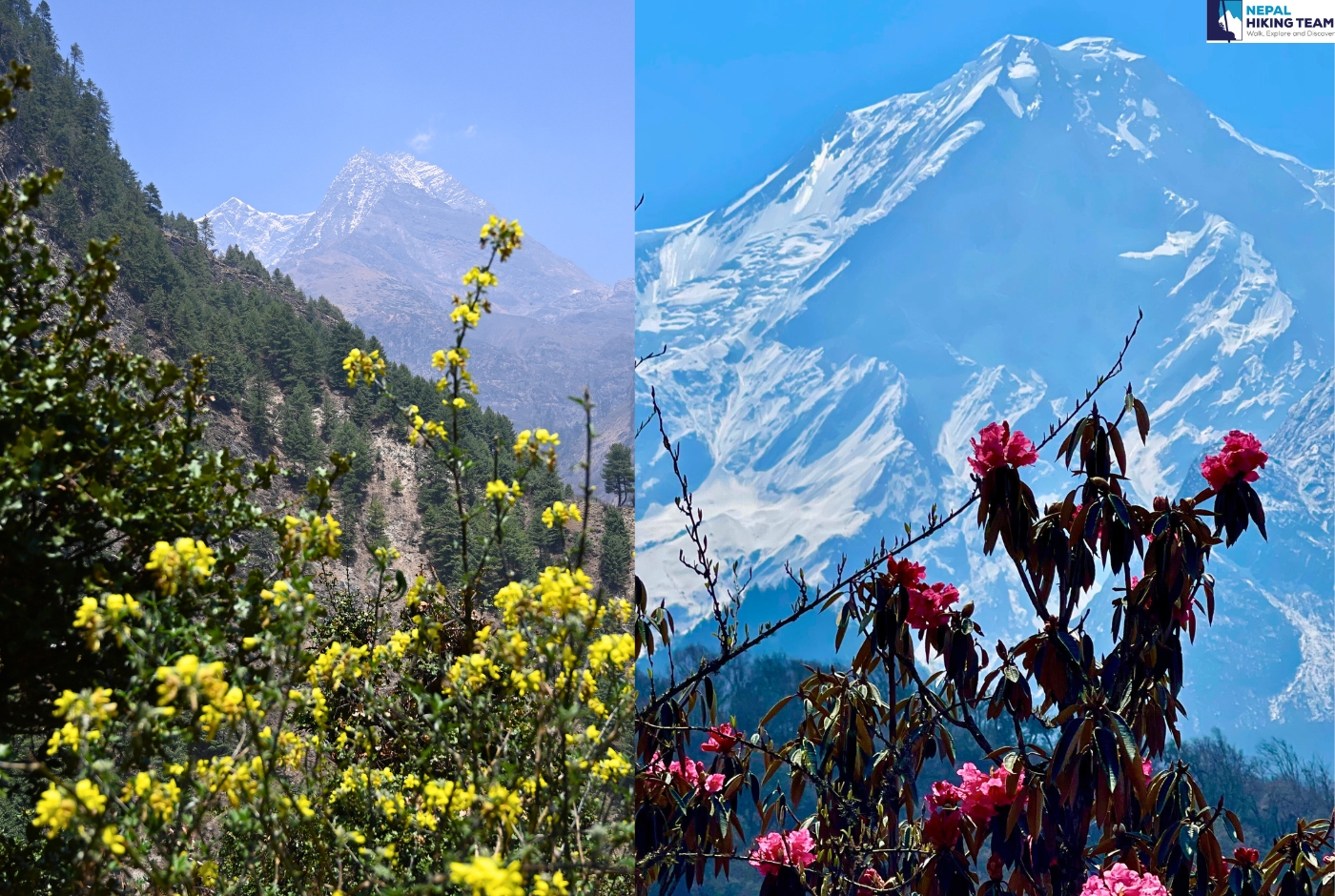
Spring tumbles from March to May in Nepal. It comes after winter and before summer/monsoon in Nepal. Hence you will get to experience the essence of both seasons that come before and after a spring in Nepal. In the earlier month of spring, the weather is quite chillier, which shows winter was around the corner.
Similarly, at the end of the spring, which is the month of May, the weather gets warmer, giving you a hint that summer is coming. Spring is flower blooming time; hence the surrounding gets colorful and green. You will get to see many flowers sprouting while on the trail and the lush green environment.
Manaslu Trek during autumn
Autumn heaves with trekkers as it is the busiest season for trekking in Nepal. Nepal experiences autumn from September to November. The season offers dry weather with crystal clear air for trekkers. Also, one reason trekkers choose this month for trekking is because of the staggering mountain views. Clear and exceptional mountain views are visible during this season. Similarly, the weather is comfortably warm in autumn.
The comfortable weather of autumn replaces the hot weather of summer/monsoon season. Similarly, as it is a pre-winter season, autumn prepares us for the winter is about to start. Henceforward, the weather in autumn is a mix of both hot and cold, therefore it has moderate weather. Likewise, the traffic of trekkers for Manaslu trek during autumn is high compared to any other season.
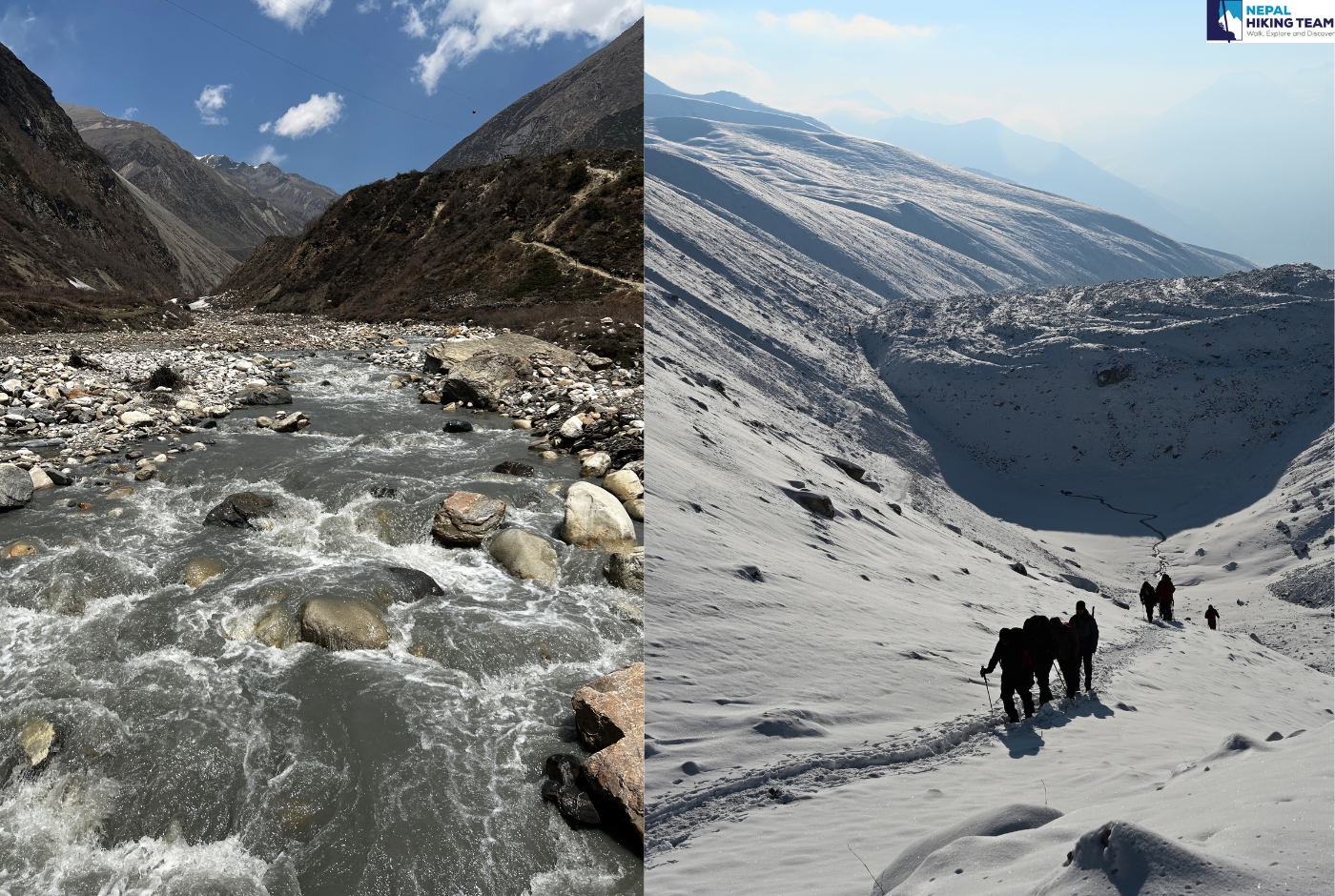
Seasons not recommended for Manaslu Trek.
Summer and winter both are pretty and exciting seasons as it offers different climates in different time zones. It is not a favorable time for Manaslu trek. Trekking in these seasons is possible, but one will have to go through lots of hurdles. In the next segment, we are outlining why summer/monsoon and winter are not a favorable time for Manaslu Trek.
Manaslu Region trek in Summer/Monsoon
Nepal experiences the summer/monsoon season together, and it falls from June to August. The Manaslu region is at the high altitude and the chances of the trail getting blocked because of monsoon rain are high. Hence there are greater chances of occurring unpredictable moments which may depict an unpleasant experience for you. Besides, the frequent encounter with the leeches and constant rain is not exactly a fun thing to experience. Therefore, we would not recommend trekking in the summer/monsoon season.
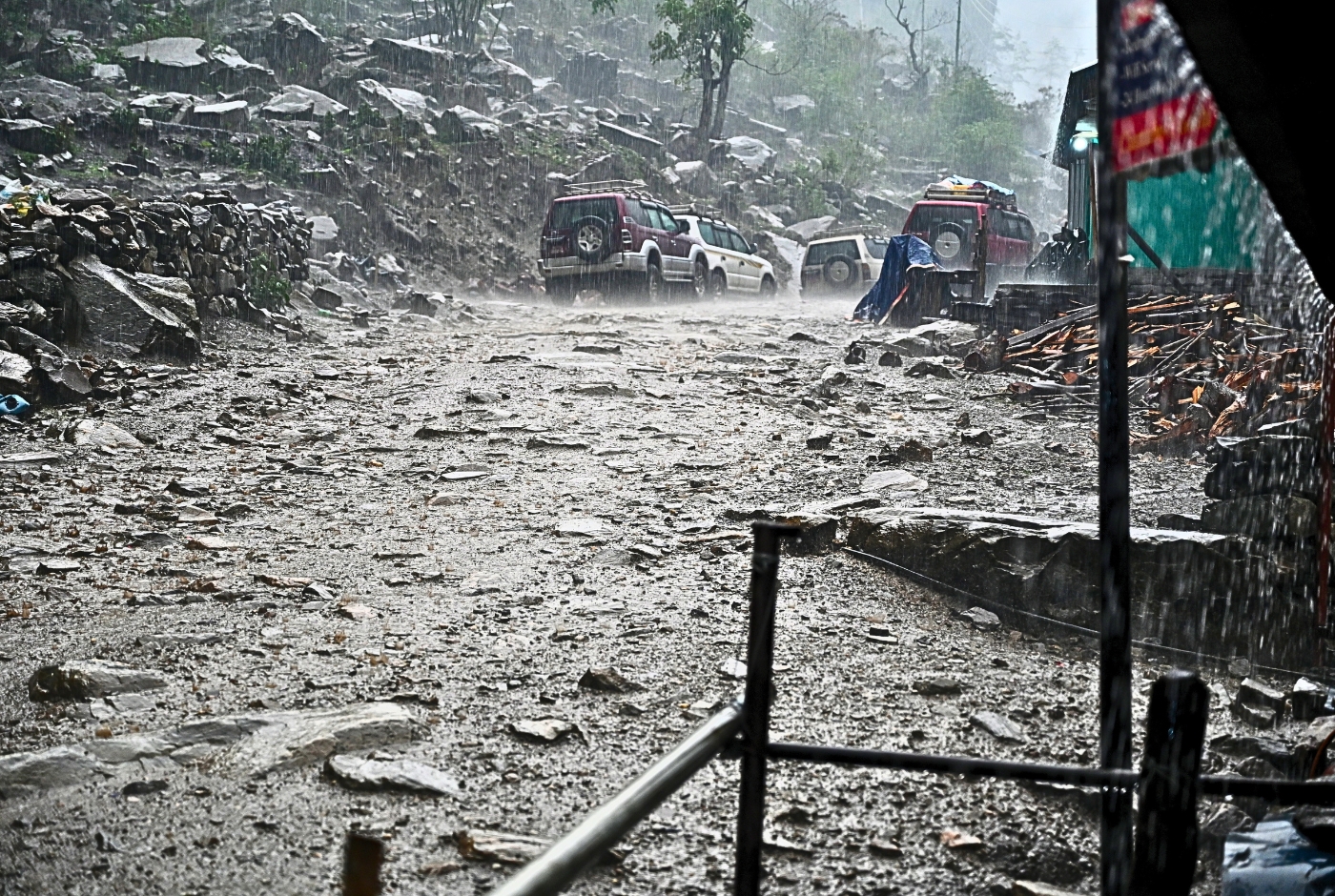
Manaslu Region trek in winter.
High-elevated areas of Nepal in winter are crucial. And as the Manaslu is one of the elevated regions of Nepal, so winter trekking can be a real endurance test. Winter in Nepal is from December to February. The views are magnificent, but the real complication of doing Manaslu trekking in winter would be the snow-blocked trail. The mountain passes would be closed off because of snow, and it would be difficult to cross them when it's snowed. Even if you are trekking with quality trekking gear, the constant passing through the snow would make you wet, and your journeying experience would not be great. Therefore, even though early winter is workable for trekking, it is not recommended to trek in the Manaslu region in winter.
What are the most commonly asked questions about the Manaslu Region?
Here are some of the frequently asked questions about the Manaslu Region, especially the Manaslu Circuit Trek.
Why is Manaslu called Killer Mountain?
Manaslu is called the "Killer Mountain" due to its dangerous climbing conditions. The mountain has a high fatality rate because of its steep slopes, unstable weather, avalanches, and crevasses, which make it highly challenging even for experienced climbers.
The name became widely known after a tragic incident in 1972 when an avalanche struck a Korean expedition, killing 15 people. This event highlighted the inherent risks of climbing Manaslu, earning it the ominous nickname "Killer Mountain.
How challenging is the Manaslu Circuit Trek?
This is a physically demanding trek with lots of ups and downs. There are several switchbacks and river crossings which makes the trek tiresome. At some sections, the trail traverses landslide areas which makes it risky. However, no technical climbing is involved. It’s straightforward walking on well-worn foot trails. The most challenging section of the trek is the crossing of Larkya La. The mountain pass is covered in snow and has some steep inclines, which makes the crossing difficult.
Is the Manaslu Circuit Trek harder than Everest Base Camp?
If you study the altitude profile of both treks, Everest Base Camp is more difficult than Manaslu Circuit. The Everest Base Camp trail takes you to elevations above 5000 meters, where the amount of oxygen in the atmosphere is only half of that at sea level. Moreover, the EBC Trek itinerary includes three nights at Lobuche and Gorak Shep, which lie at an altitude of 5000 meters. Sleeping and walking at this altitude is certainly not easy.
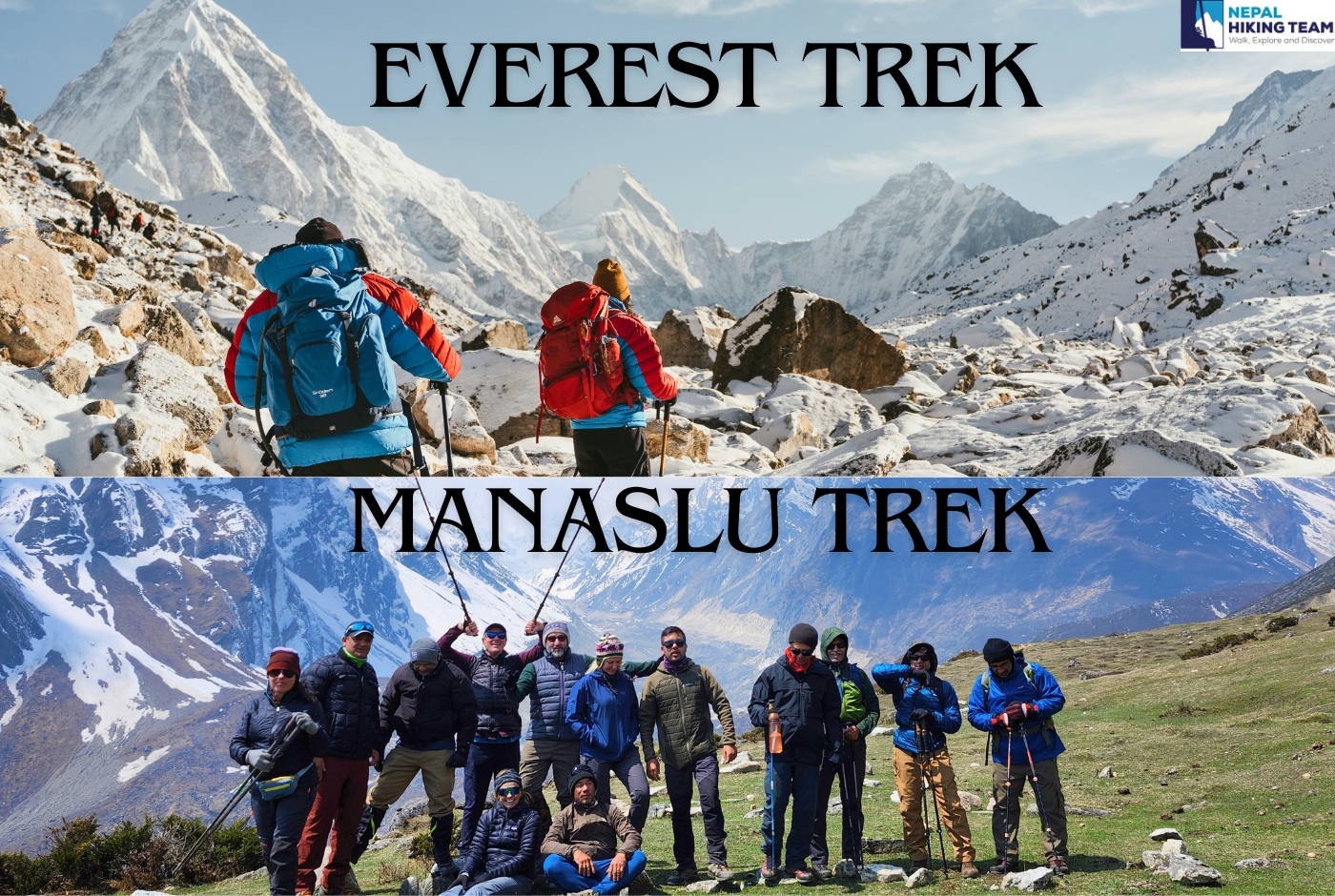
The highest point on the Manaslu Circuit trail is the Larkya La pass which lies at an elevation of 5106 meters. While the trek to the pass is challenging enough, the time spent at the pass is only a few minutes. After getting up on the pass you will make a quick descent to Bhimthang, which lies at an altitude of 3590 meters.
While there’s not much of an elevation gain on the Manaslu Circuit, the winding and narrow trails across uninhabited stretches make the trek physically tiring. The villages are located further apart, and it takes a long hike to reach inhabited villages on the trail. The Everest Base Camp trail has many Sherpa settlements en route where one can stop to eat and rest at intervals.
The Everest trail also has well-facilitated lodges and teahouses, which raises the comfort level of the trek. There are also luxury mountain lodges on the Everest trail, which offer high-end services to the trekkers.
Compared to the Everest Base Camp trail, the teahouse facilities on the Manaslu Circuit are more basic and rustic. The lodges are not as modern and well facilitated as on the EBC trail. However, the increased traffic in the Manaslu Region in the past few years has led the locals to upgrade the teahouse facilities.
How to train for Manaslu Trek?
It’s important to be relatively fit before you start your trek. You can start training for your trek at least six months in advance. You can take uphill hikes carrying a heavy backpack, climb stairs and jog. You can take up strength-building exercises to develop your back, core and leg muscles. Regular cardio workouts (swimming, aerobics, cycling, running, etc.) will build up your stamina and make your heart and lungs stronger. It is also important to have a balanced diet while training for your trek.
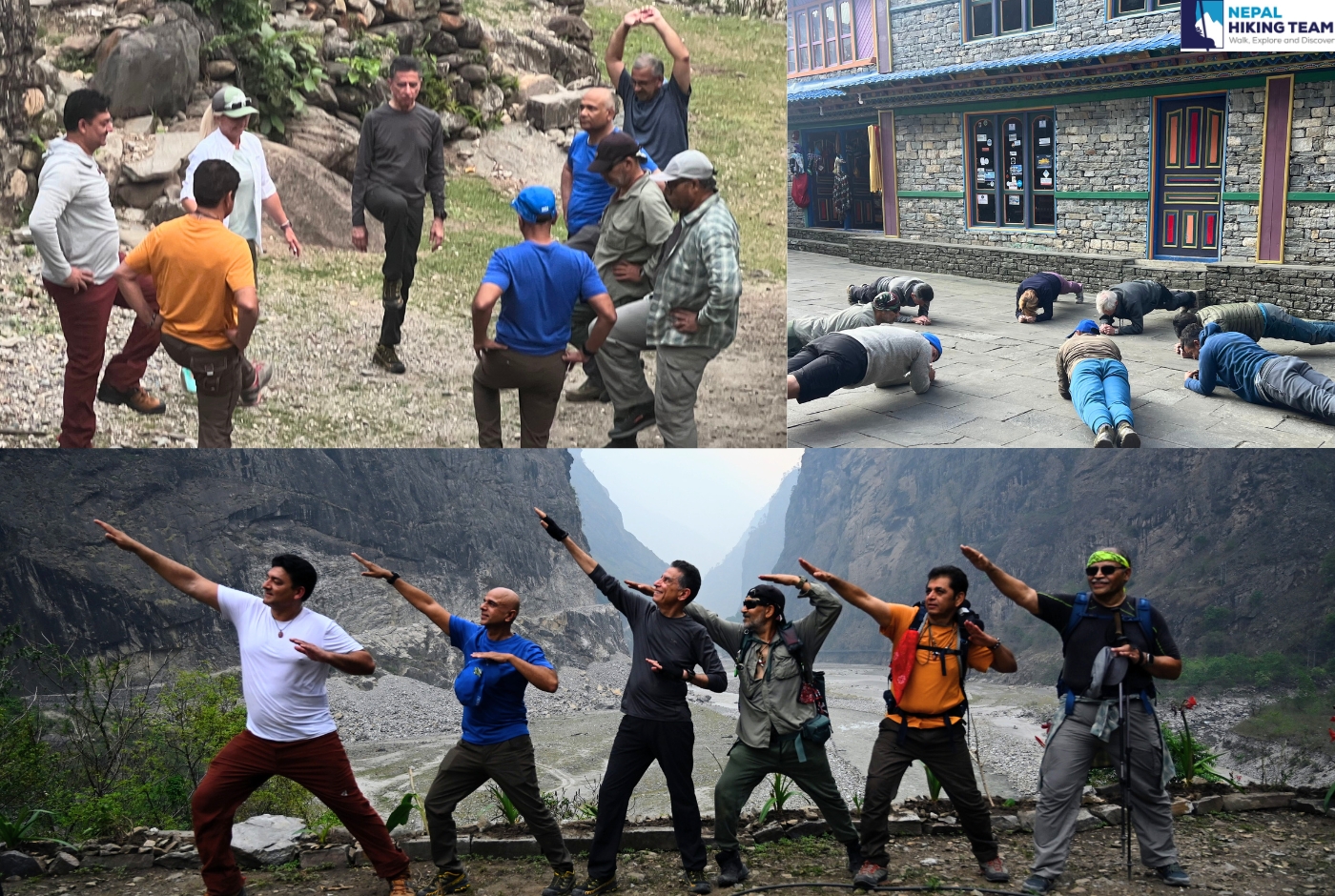
It is difficult to train for a high-altitude trek while staying at a lower elevation. However you can take precautions while trekking to avoid altitude sickness. Some of the steps you can take to mitigate the effects of high altitude on your body are keeping yourself hydrated by drinking lots of fluids, keeping yourself warm, maintaining a slow but steady pace while walking, taking deep breaths and never overexerting yourself.
Is Manaslu Circuit harder than Annapurna Circuit Trek?
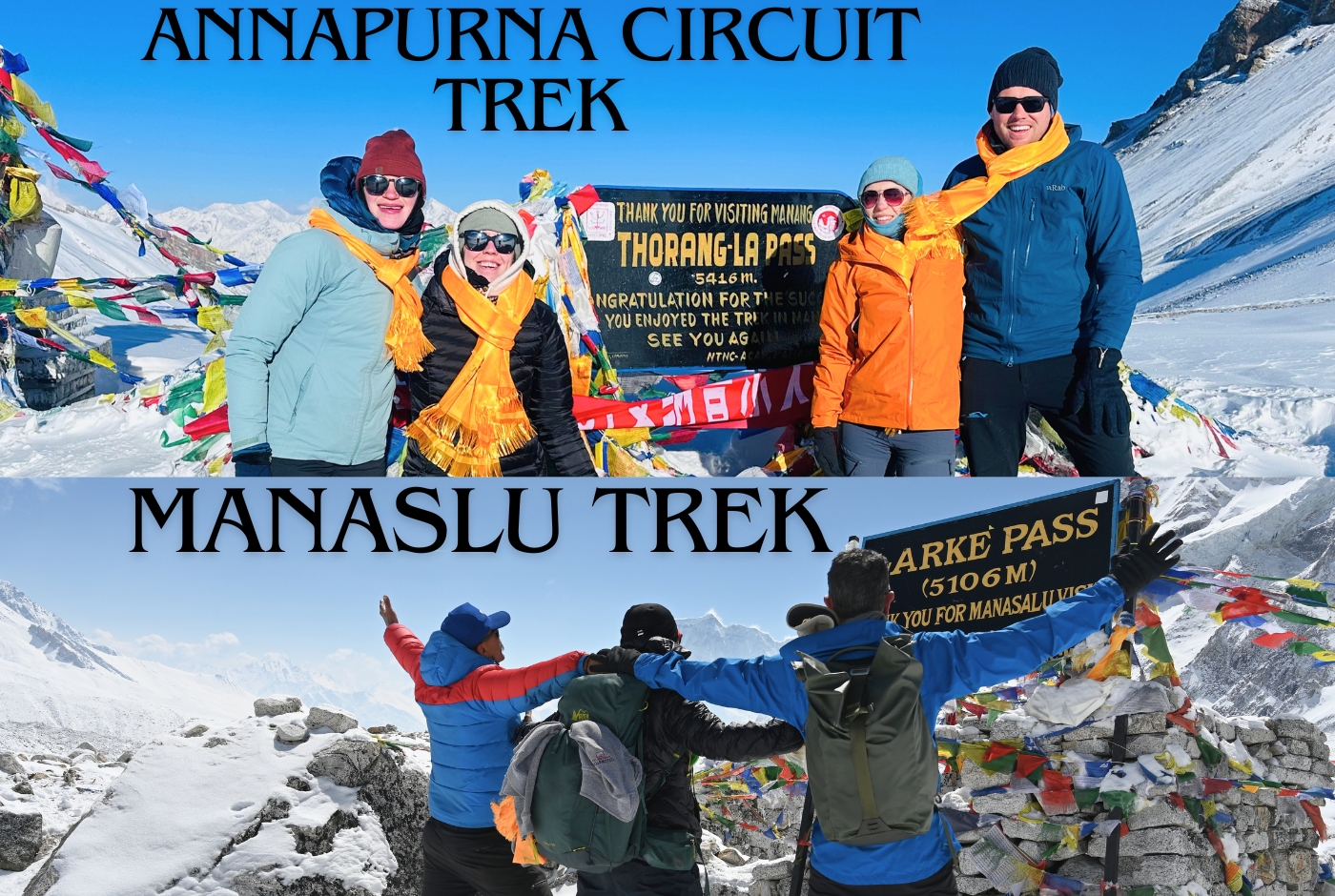
The Manaslu Circuit is a bit more demanding than the Annapurna Circuit. There are a lot of ups and downs during the first few days of the Manaslu Circuit Trek which makes it physically exhausting. There are several switchbacks and river crossings which makes the Manaslu loop harder than the Annapurna Circuit. The lodges are also basic on the Manaslu side, and the villages are also situated farther apart, which makes for long days of walking each day.
Annapurna Circuit has many villages en route with comfortable lodges. The rough jeep tracks of the Annapurna Circuit are also easier to navigate than the winding and rocky trails of the Manaslu Circuit.
What is the difficulty level of Larke La Pass?
The Larkya La Pass sits at an altitude of 5106 meters and is the highest point of the Manaslu Circuit Trek. Crossing the pass is pretty challenging as one will be walking on snow and ice and climbing and descending on steep sections. It takes around 8-9 hours’ hike from Dharamshala to cross the Larya La pass. The pass is covered in snow and ice, which makes the crossing difficult. You will start your trek before daylight. The weather starts to worsen as the day progresses, so it’s wise to make an early start. It is a tiring hike up to the pass past boulder fields and icy paths. The freezing cold and low oxygen level make the trek harder. The steep descent to Bimthang is equally hard and challenging. A big reward for the challenging crossing of Larkya La is the stunning and breathtaking views of the mountains.
How long is the Manaslu Circuit Trekking?
The length of the trek depends on the itinerary you choose and the pace you maintain during your trek. Usually, it takes around 11 to 14 days to complete the Manaslu Circuit Trek. However, the trek can be stretched to 18 days or more, depending on the detours and side trips. Most trekkers prefer to include a side trip to Tsum Valley, which takes an extra four to five days. From Machakhola to Dharapani, the trail is about 180 kilometers long.
How much does the Manaslu Circuit trek costs?
Every outfitter charges a different fee for the trek. The cost of the trek depends on the agency you choose, the services you are willing to pay for and how much you will spend on the trail (on hot showers, wifi, snacks, drinks, etc.). If you only pay for the guide and porter service, the agency will charge you less. But if the accommodation costs, meals, and transportation fees are also included in the total cost of your trip, then you will have to pay a hefty sum. It is better to let the outfitter take care of all the logistical details to make your trek hassle-free. Permits are also included in the total cost.
Is it worth doing the Manaslu Circuit Trek?
Yes, the Manaslu Circuit trail is definitely worth experiencing. The trail takes you off the beaten path to some of the rarely explored areas in the Himalayas. The forests along the trail are pristine and untouched. The natural beauty and the close-up view of an eight-thousand-meter peak make this trek one of the best multi-day treks in the Nepal Himalayas.
What do you need for Manaslu Circuit?
To do the Manaslu Circuit Trek, you need to have
- All the required permits
- Passport with six months validity
- A licensed guide
- Appropriate clothing and equipment, including a sleeping bag, warm clothes, crampons or microspikes
- Rainproof gear
- Sturdy shoes
- Travel Insurance which covers high-altitude rescue
- Essential Medicines (painkillers, antibiotics, Diamox, anti-diarrhea pills, etc.)
- Enough cash (local currency)
- Extra batteries and power bank
How far is Manaslu from Kathmandu?
The trailhead of the Manaslu Trek, Machha Khola, is located approximately 160 kilometers away from Kathmandu, and it takes about 7-8 hours to drive there. However, the actual mountain, Mount Manaslu, is further away and requires a 4-5 day hike from the trailhead.
Can you trek to Manaslu without a guide?
No, trekking without a guide is not allowed in the Manaslu Region. Since the region lies in a restricted area, it is mandatory to trek with a local guide.
How much is a Manaslu Trek permit?
As of September 2024 the cost of the permits are as follows :
Manaslu Conservation Area Permit –
- For nationals of SAARC countries – NRS 1000/- per person
- For other nationals - NRS 3000/- per person
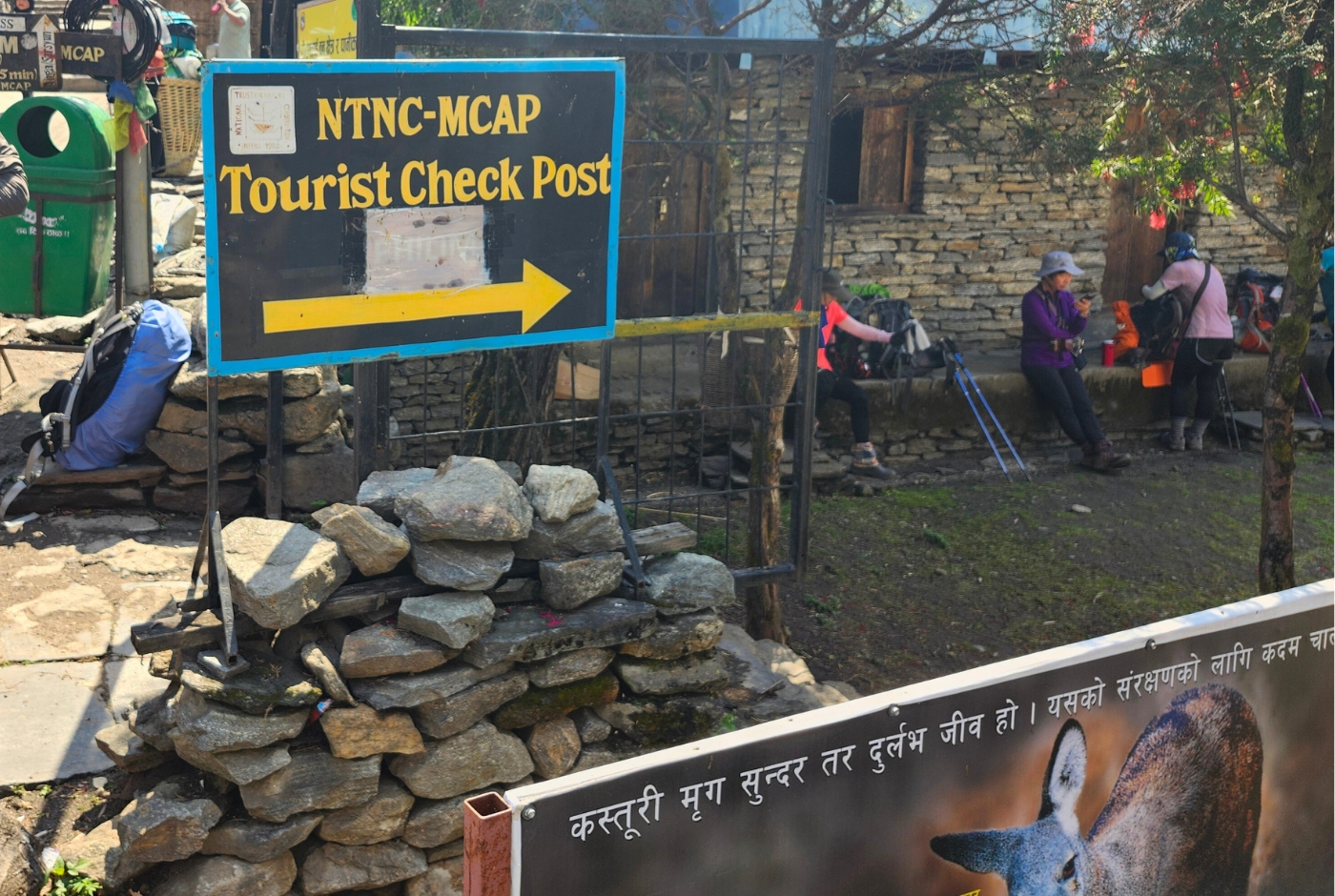
Manaslu Restricted Area Permit -
- September to November – USD 100/- per person per week and an additional USD 15/- each extra day
- December to August – USD 75/- per person per week and USD 10/- each extra day
Annapurna Conservation Area Project Permit:
- For SAARC nationals – NRS 1000/- per person
- For Other Nationals – NRS 3000/- per person
If you want to visit the Tsum Valley, you will have to further pay an additional fee of USD 35 for a week’s trek.
Can you do the Manaslu Circuit Trek solo?
No, solo trekking is not allowed in the Manaslu Circuit. Since Manaslu Region is a restricted zone, it is mandatory to trek with a licensed guide; There should be at least two people in a group.
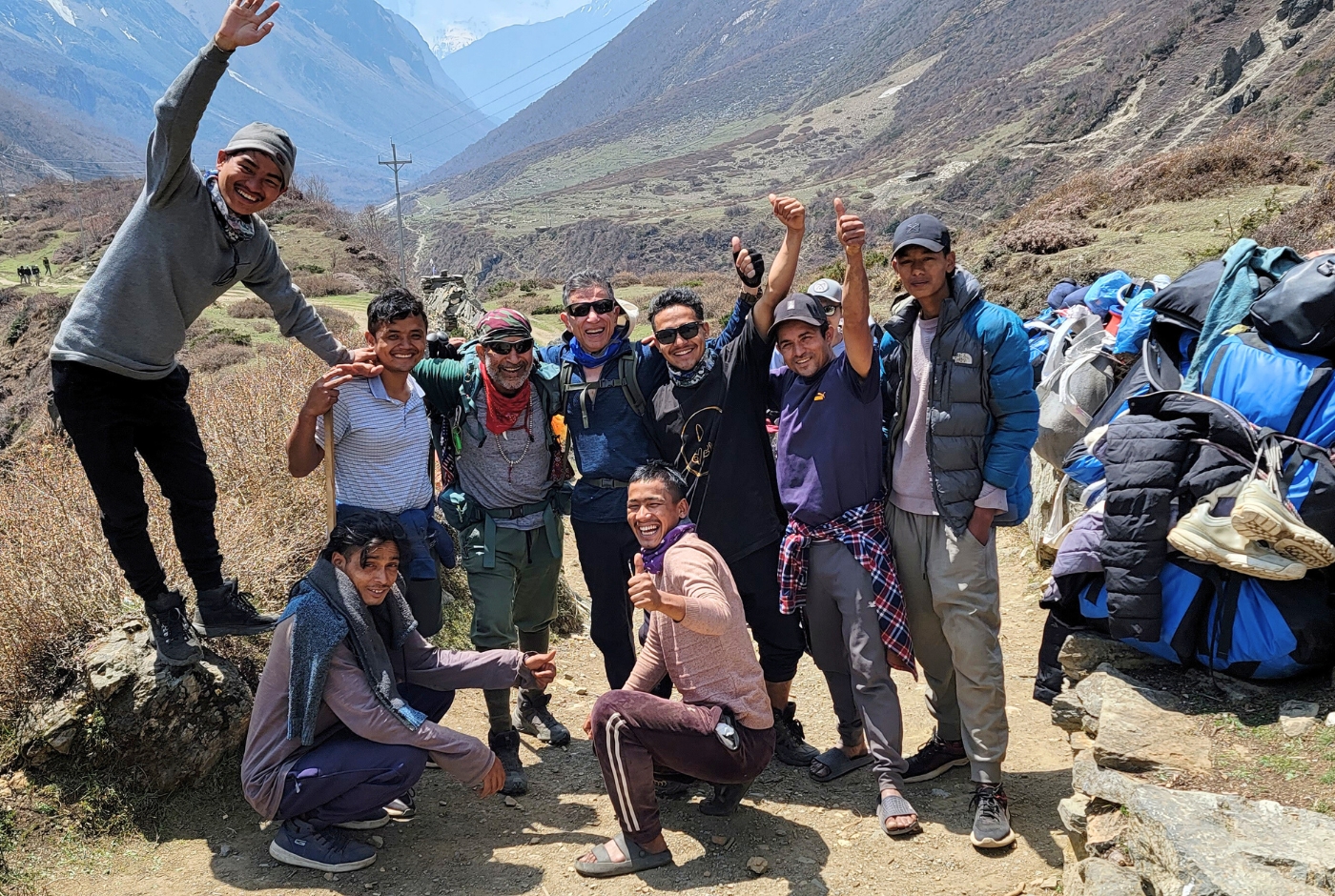
How many kilometers is the Manaslu Circuit Trek?
The distance you cover depends on the starting and ending points of your trek and the side trips you will take en route. From Machha Khola to Dharapani distance is roughly 110 kilometers.
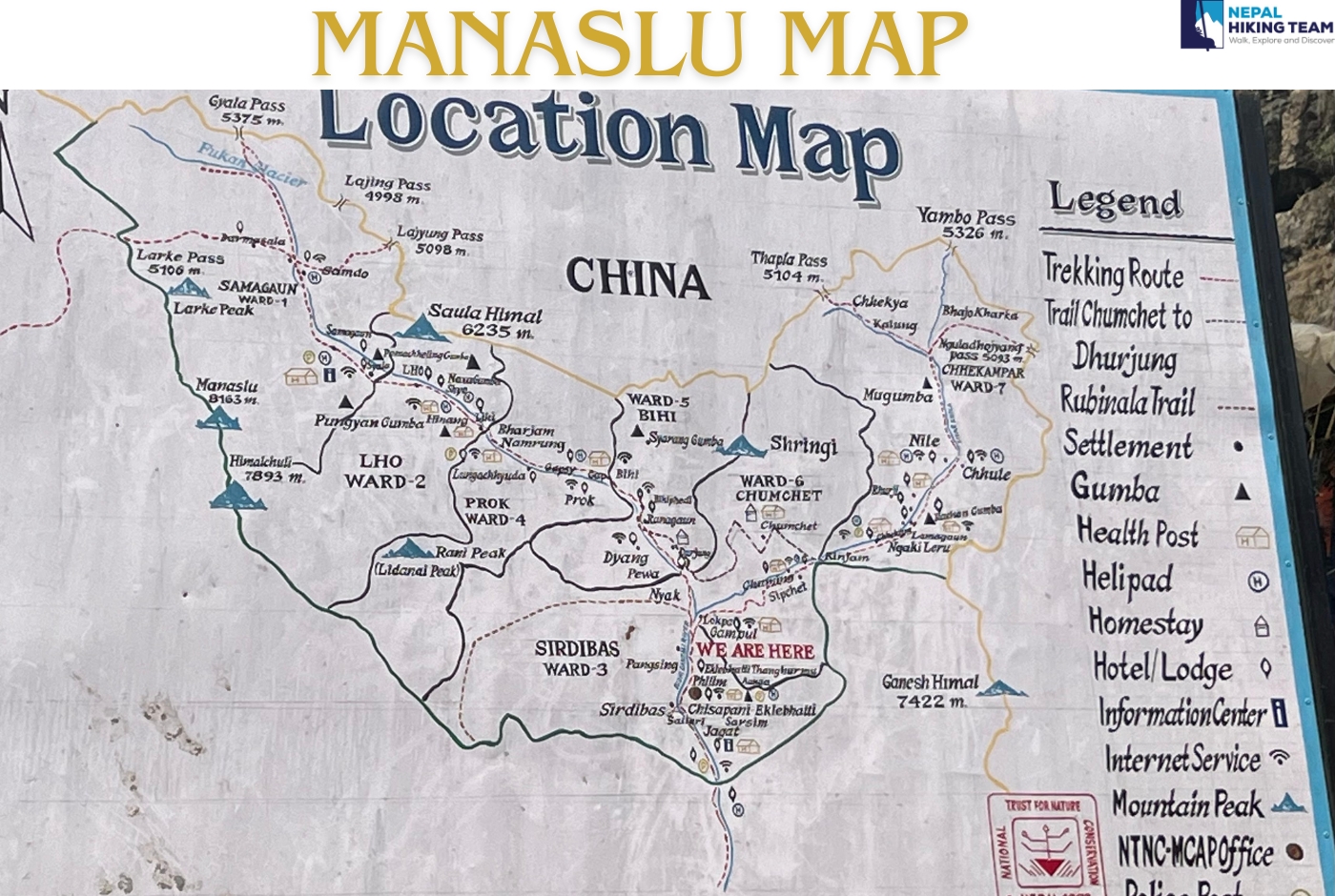
What about traveling solo to the Manaslu region?
Traveling Solo in the Manaslu region is not possible. Manaslu region is a restricted trekking area of Nepal, so to trek in any part of this region, it requires you to purchase a trekking permit. Also, trekking permits can arrange through a trekking company. You must trek with a registered guide in a part of two or more. Hence, solo traveling to the Manaslu region for foreigners is not possible.
What kind of accommodation can I find along the route to Manaslu?
As per the accommodation, in the lower part of a teahouse, you can get to stay in a room with twin beds to share amongst two adventurers. You can discover rooms with a connected washroom in Soti Khola, Machha Khola, Jagat, Namrung, Samagaun, Dharapani, Bhimtang, and Chamje. However, as you move higher up, the standard of the tea house diminishes. All things considered, rooms are simple, and they set beds with a sleeping mattress, bedsheet, and cushions for your solace.
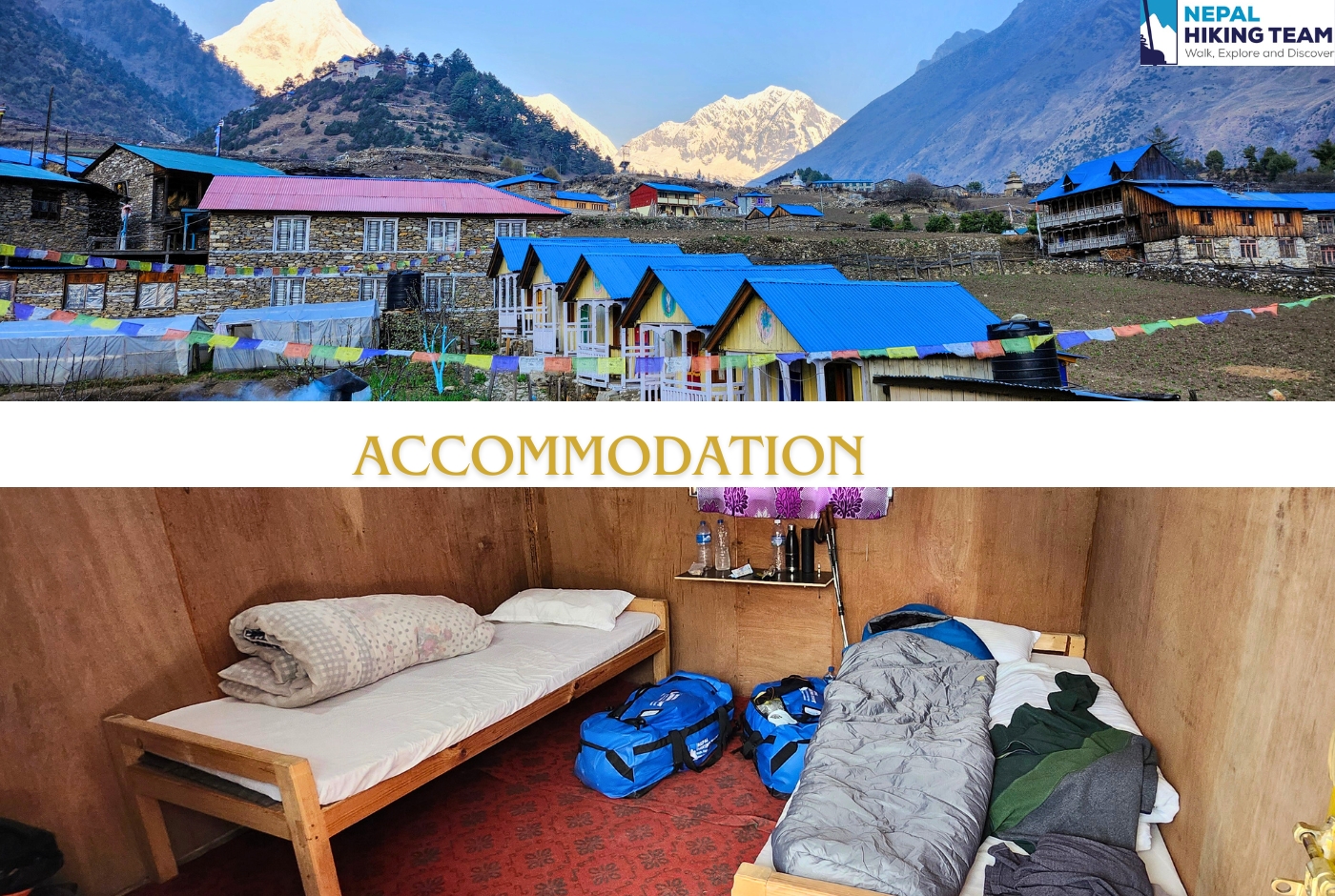
What types of food can I expect during the Manaslu trek? Are there options for people with dietary restrictions on the Manaslu Region?
Food is a crucial part of the trek. During the Manaslu trek, you will find a variety of dishes to satisfy you. From local traditional dishes to international meals, you will find almost everything on the trek. Teahouses provide their guest with a food menu where they can find a variety of dishes and request anything you like from the menu. The menu contains local traditional foods and international meals.
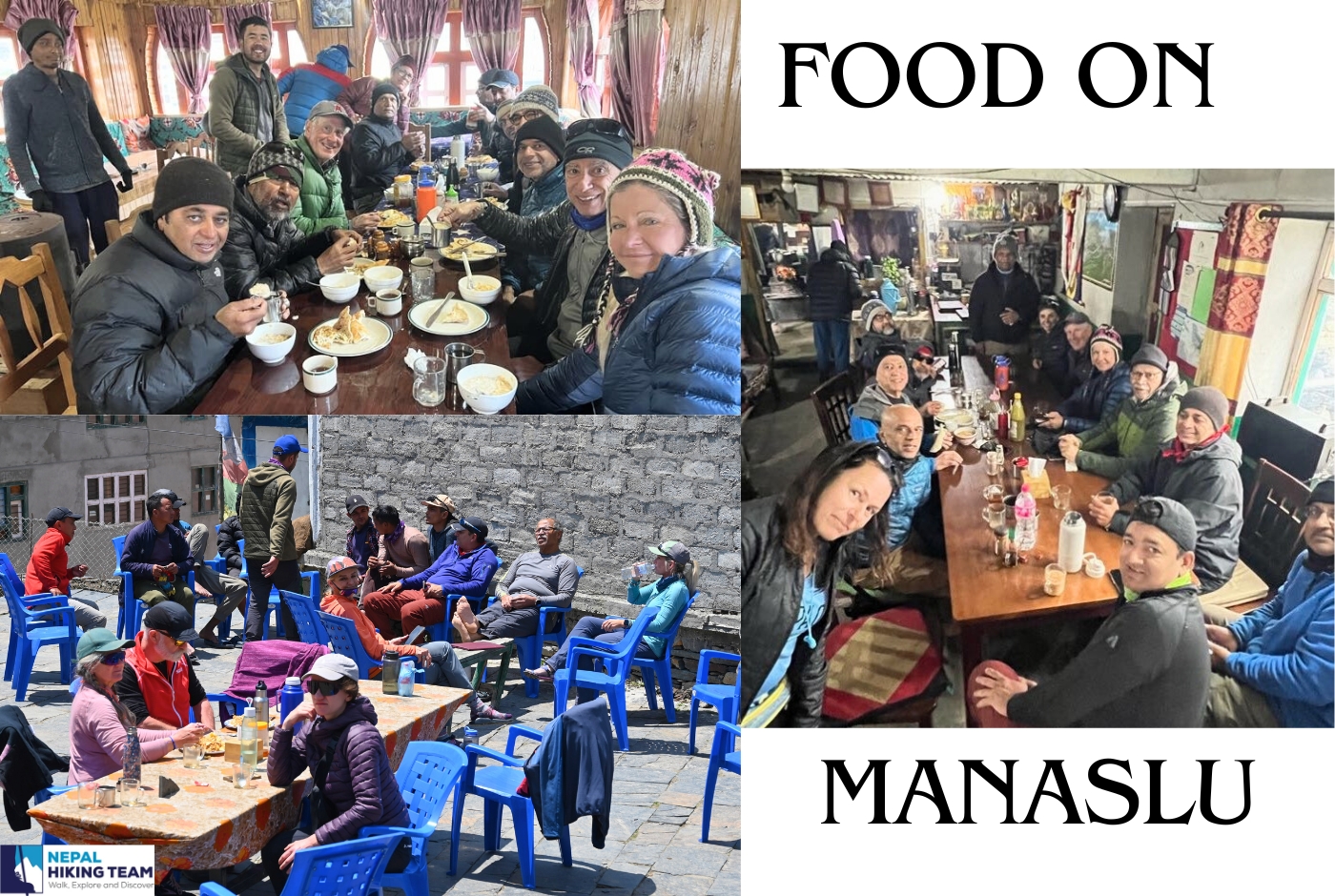
Similarly, if you have dietary restrictions, then also do not worry. Because cooks at the teahouse will prepare meals as per your request, keeping your restrictions in mind. Hence, if you are vegan or would like to eat veg meals or you need to eat gluten-free meals, dishes, inform your guide before ordering your meals from a menu. They prepare as per your requirements.
Is safe drinking water available? What are the best options for safe drinking water during the Manaslu trek?
There are three available options for accessing drinking water on the trek. These available options are to buy bottled water, purchase hot water, or filter the spring water. Bottle water for purchase is available everywhere, and it costs up to NPR 300 per bottle. Also, you can purchase hot boiling water at the teahouse and it costs up to NPR 200 per liter.
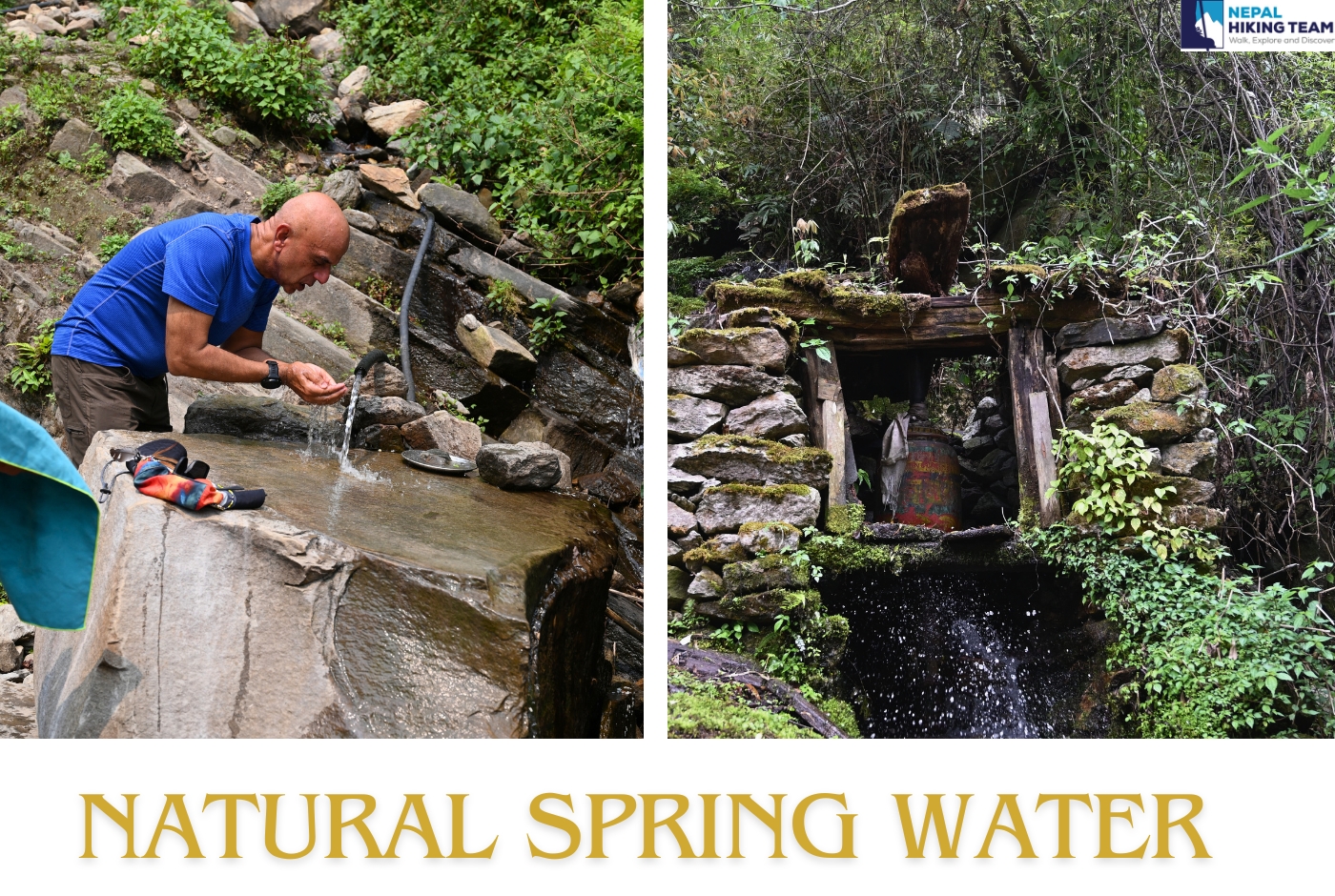
And for the last alternative is to filter spring, water will not cost you a penny on the trek. It is a highly recommended alternative among all the mentioned methods. For this, you just need to bring water purification tablets, purify water for about 30 minutes and you can drink water.
Is WIFI available in Manaslu? How can I stay connected during the Manaslu trek if WIFI is not available?
WIFI is available at the lodges except for Dharamshala at the moment. For the services, it cost some fee. Similarly, phone coverage is also available. Therefore, we would recommend you purchase a sim card. You can find phone reception in Soti Khola, Jagat, Nanrung, Samagaun, Tilje, Dharapani, and Chamje.
When wifi/internet is not working, the most reliable means of communication is phone reception. When there are no WIFI services available, you can use internet data packages via a local SIM card. Also, for internet services, all the teahouses provide internet package in this trek route. It cost around NPR 500.00 which you can use while at the teahouse, and until you leave the teahouse. This provision is one of the well-considered ways to use internet services by trekkers.
Tour du Manaslu: Why should you choose Manaslu Circuit Trek?
You should choose the Manaslu Circuit Trek for the authentic cultural experience. The trail is also less crowded and less commercialized. You will get to meet indigenous groups following the same lifestyle as their ancestors. Another reason for choosing this trek should be the amazing views of the eighth-highest mountain in the world, Manaslu.
What treks are popular in the Manaslu Region?
Did you enjoy reading the Manaslu Trek blog? If so, look at the various trekking trips in the Manaslu Region. Here are two recommended itineraries for your next adventure:
Manaslu Trek with Tsum Valley - 20 days
These options provide different durations and experiences, allowing you to choose the one that suits your preferences and time availability.
Final Words for Manaslu Trek
This Manaslu Trek Guidebook incorporates all that you have to think about the Manaslu area. This Manaslu Trek manual will be useful in arranging and getting ready for your up-and-coming experience. On the off chance that there is much else you have to think about the trip, kindly drop a message to our support team. They associated with you to help you with your uncertainty. The Manaslu Trek is an incredible excursion in the remote territory of Nepal. The beauty and the legitimacy of the locale are outstanding and admirable.
If you are making a one-time visit to Nepal and want to truly experience an authentic Himalayan adventure, then we recommend you do the Manaslu Trek. The pristine landscape, authentic culture, challenging hike, and interesting encounters with the indigenous mountain communities will surely leave an everlasting imprint in your memory.



